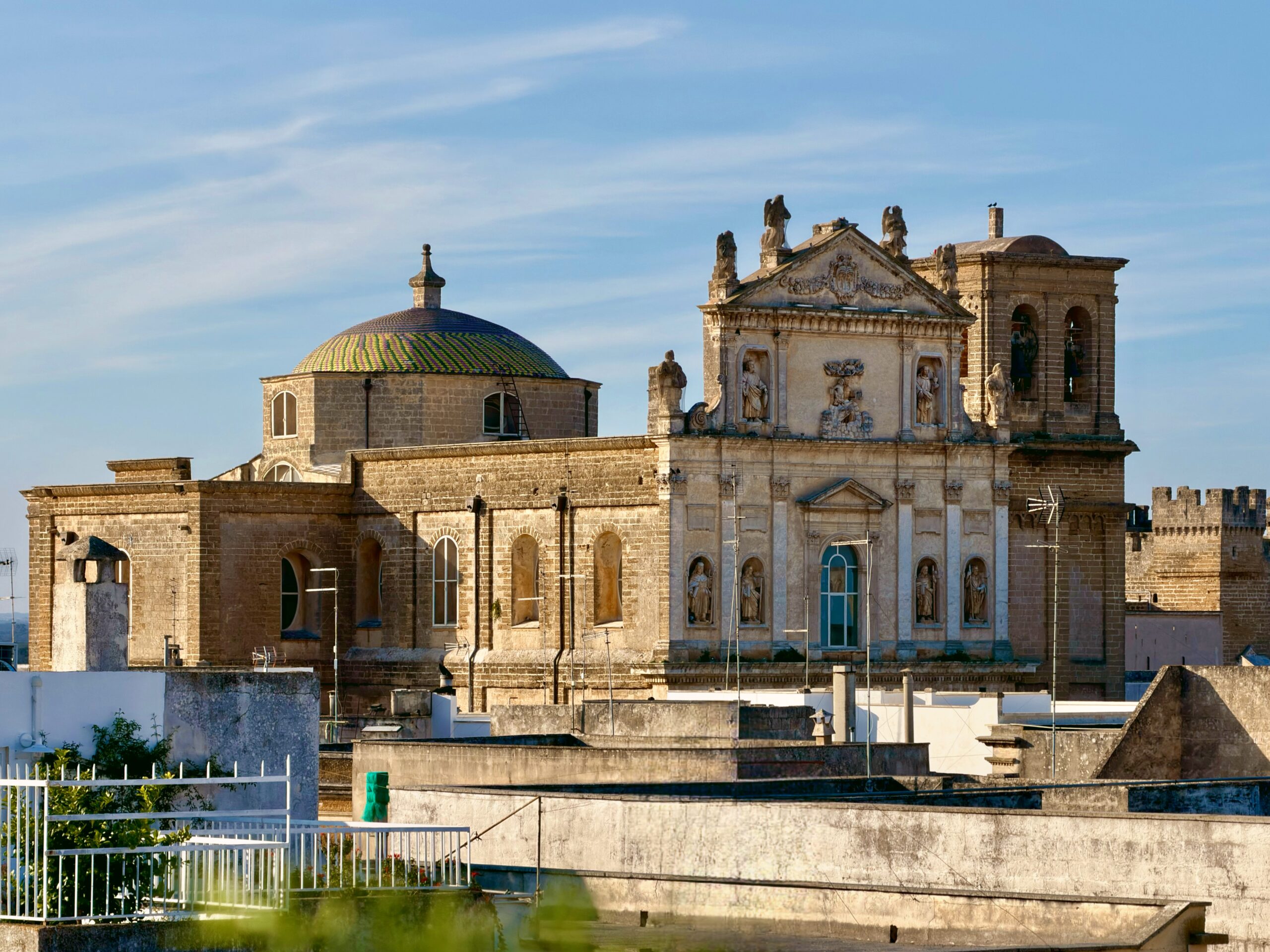History, heart (and a heart-shaped historic centre).
Mesagne sits quietly on the final stretches of the ancient Via Appia, halfway between Oria and Brindisi (the town’s name in Roman times was Medianum, highlighting its importance of being “in the middle” of a communications and transport axis linking the two). It’s a town that manages to blend layers of history with southern ease — from its Messapian roots and baroque façades to its lived-in piazzas and evening passeggiata: authentic, walkable and full of life. A small inland city that captures the soul of Salento without the crowds.
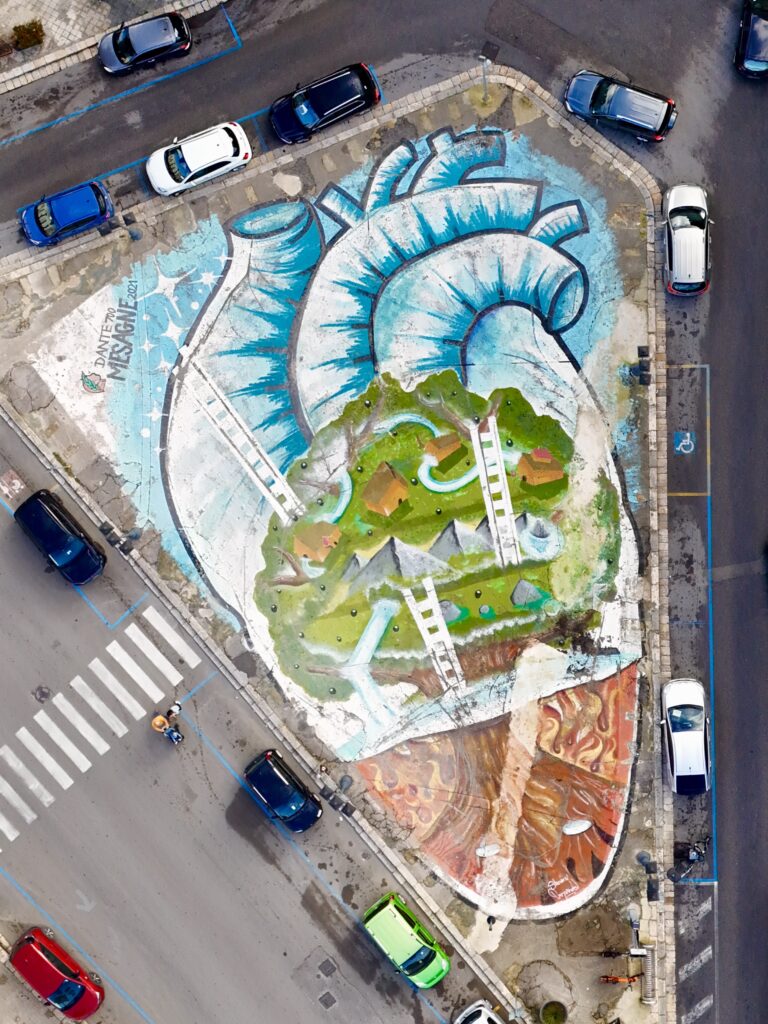
Why Mesagne makes a smart base
Mesagne sits on the regional Brindisi–Taranto rail line, with direct links to Brindisi (15–20 minutes) and Taranto (around 50–55 minutes).
From Brindisi, you can connect north along the Adriatic spine to Ostuni, Monopoli, Bari and beyond, or south to Lecce — all without needing a car. Mesagne’s train station lies just a short walk from the historic centre, making day trips simple even without a car. By day, explore widely by train: a morning on the coast, an afternoon in Taranto’s MArTA museum, and an evening back in Mesagne’s vibrant piazze.
The old town is compact, lived-in and relaxed. Set on flat terrain, Mesagne is easy to explore on foot. The old town unfolds gently from the Porta Grande, its lanes lined with courtyards, cafés and baroque façades, without the steep climbs you find in Ostuni and Carovigno.
Mesagne is a popular draw for people from nearby towns, known for its bars, restaurants and its growing reputation as a fashionable, buzzy place to eat out and have drinks.
As a base, Mesagne combines authenticity, accessibility and value. With good road and rail connections it offers the freedom to explore much of Puglia while staying firmly off the beaten track.
“Mesangeles” – what the locals call home

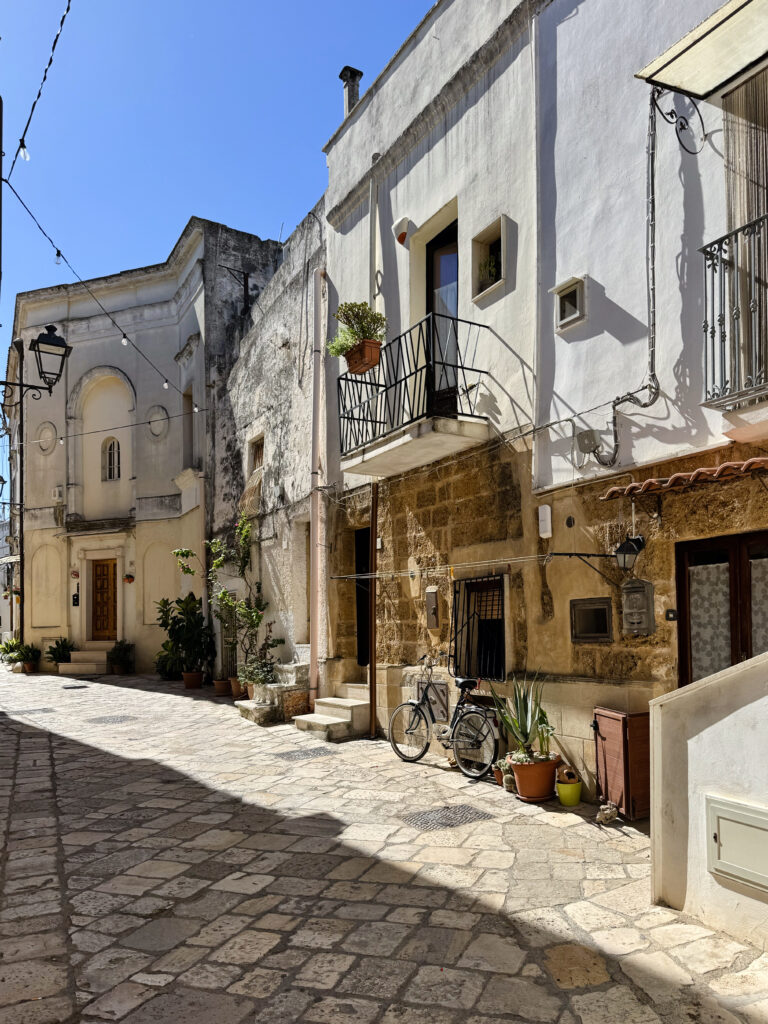
Spend even a few hours in Mesagne and you’ll hear it affectionately called “Mesangeles” — a tongue-in-cheek nickname locals use to celebrate their city’s surprising energy. The name started as a joke (Mesagne meets Los Angeles), but it’s stuck, and with reason. For a town of just 25,000 people, Mesagne feels lively, cultured and confident — full of cafés, music, and year-round events.
Don’t expect palm-lined boulevards or movie studios, but do expect that same sense of pride and possibility. The nickname sums up what locals love most about their town: that it’s big enough to have life and rhythm, yet small enough that everyone still knows your name.
According to our sources, Mesagne is a trendy and fashionable choice for young people. It’s bars, restaurants and shops are a draw from nearby towns.
Quick take
- Province: Brindisi
- Best for: slow travel, architecture, food, Messapian history, local festivals
- Stay: 1–2 nights passing through, 3-4 nights as a base
- Getting there: 15 km from Brindisi, 55 km from Taranto, 40 km from Lecce
- Vibe: compact, walkable, quietly elegant. By night, Mesagne draws a younger crowd from nearby towns — it’s become a go-to spot for aperitivi, bars and relaxed dining, giving the old town a lively, social energy.
Orientation


Mesagne’s historic centre is one of Puglia’s most distinctive — enclosed within 15th-century walls that form an unmistakable heart shape when seen from above. The town stands along the final stretch of the ancient Via Appia Antica, the great Roman road that once ran from Rome to Brindisi. Portions of the original route survive nearby at the archaeological park of Muro Tenente, reminding visitors that this was a key stop, linking the Messapian settlements of the Salento with the wider Roman world.
The main gateway into the centro storico is Porta Grande. Over to the right stands the Norman-Svevo Castello Orsini del Balzo, whose origins may date as far back as the mid-11th century. Over time it evolved into a baronial palazzo, passing through various noble hands before becoming home to the Museo del Territorio “Ugo Granafei”. You can wander around the outer courtyard and surviving ramparts for free, but the small entry fee (€3) to the museum is well worth it — not least for its reconstructed prehistoric tomb and the rich displays of artefacts that trace Mesagne’s Messapian and Roman past.
The centro storico itself is compact and intimate. You can walk around most of it comfortably in under an hour, unless you stop to explore the churches — mainly baroque, dating from the 17th and 18th centuries. The most important are the Chiesa Matrice and Chiesa di Sant’ Anna, both finely decorated and worth a peek inside. Keep an eye out too for the smaller chiesette, tucked into corners and courtyards — their modest façades often hide unexpectedly beautiful interiors.
Continue along Via Azzolino, known locally as la via fiorata (“the flowered street”), where geraniums spill from balconies and doorways open straight onto the street.

A short history
Long before its baroque palazzi and heart-shaped centro storico, Mesagne was already a place of settlement and exchange. Its story stretches back nearly three millennia, shaped by the Iapygians, the Messapians, the Romans, and later by the feudal families who left behind the castle and churches we see today.
The Iapygian Village
Around 2,700 years ago, Mesagne was home to a small Iapygian village, one of many that dotted the fertile Salento plain. It stood between the area now marked by Porta Grande and Piazza Mercato, enclosed by a defensive wall whose foundations can still be seen in the archaeological area of Vico Quercia.
The village was made up of simple circular huts, built from dry stone with reed-and-branch roofs supported by wooden poles. At their centre was a hearth — the hub of domestic life — while outside, families worked as hunters, herders, potters and farmers. Traces of kilns, grinding stones and animal enclosures point to small-scale production for local trade.
Among the most striking finds from this period are anthropomorphic stone stelae — upright gravestones carved with symbolic motifs like horses, carts and spears, representing high-ranking individuals and early forms of social hierarchy.
The Messapian and Hellenistic Periods
By the 6th century BC, Mesagne had become part of the Messapian civilisation, one of three major tribes (with the Peucetians and Daunians further north) that defined ancient Puglia. The Iron Age huts gave way to stone-built houses with tiled roofs, laid out along wider streets with workshops, temples and cemeteries.
During the Hellenistic Period (4th–3rd centuries BC), the settlement expanded dramatically as population and trade grew. New neighbourhoods emerged within fortified walls, divided by open fields and sacred enclosures. In the Vico dei Quercia archaeological area you can still trace a street running parallel to the earlier Iron Age wall, lined with semi-chamber tombs and the remains of a small sanctuary.
The Necropolis of Via Castello has revealed decorated burial chambers and Messapian inscriptions — evidence of a prosperous and cultured community influenced by the nearby Greek colonies of Taranto and Brindisi.
From the Romans to the Middle Ages
When the Romans arrived, Mesagne (then Medianum) became an important stop along the Via Appia Antica, the great Roman road connecting Rome with Brundisium (modern-day Brindisi), and the eastern ports of the empire. Being on this route meant strategic significance: trade, communication, military movement and cultural exchange. The Messapian centre gradually evolved into a small Roman town with villas, baths and necropolises; one of its finest mosaics, from the Malvindi thermal complex, is now displayed in the local museum.
Evidence of the Via Appia remains. Portions of the original roadbed have been uncovered and restored (notably at Muro Tenente). Roman milestones, the road-markers of their time, found in the area have been linked to restoration by Emperor Constantine in the early 4th century AD.
By the 9th century AD, Puglia was under Byzantine rule, and the area around Mesagne was organised into small rural settlements known as chorìa. The earliest known mention of Mesagne itself — written as Meganghe — appears in a document from 947, referring to lands belonging to the monastery of San Vincenzo al Volturno.
During the High Middle Ages, Mesagne became a castrum — a fortified settlement dominated by its castle and church — and by the 15th century it had taken on much of its current urban form. The Del Balzo Orsini family, then feudal lords of Mesagne, strengthened the town’s defences with walls, twenty-two towers and two main gates to face the growing Ottoman threat across the Adriatic.
Renaissance and the Pendino District
Mesagne’s golden age came in the 1500s and 1600s, when noble families and military-religious orders transformed the medieval town into a place of palazzi, churches and civic pride.
By the 16th century, Mesagne’s fortified core was surrounded by small residential and commercial quarters. One of these, the Pendino district, lay just below the castle. It was both a working neighbourhood and a trade zone, with workshops and storage silos for oil, grain and wine — testifying to Mesagne’s role as a thriving agricultural hub.
A wealthy merchant named Giovanni Corciulo owned much of the land here, operating warehouses that supplied the baronial estates. Even today, beneath the narrow lanes around Vico Quercia, the remains of silos, workshops and medieval foundations can still be traced — the buried memory of a town whose prosperity rested on its fertile soil and steady trade routes.
You can still see that wealth in its façades today. In the centuries since, Mesagne has remained agricultural at heart — olives, vines, and later, small-scale industry — but its historic core has been beautifully restored and feels very much alive.
Mesagne’s historic centre is enclosed by its 15th-century walls — still clearly visible today and famously heart-shaped from above. The layout, gates, and narrow stone-paved lanes reflect a long history shaped by its position on the Via Appia Antica, the great Roman road that once connected Rome to Brindisi. You can still see a restored section of this ancient route at the Archaeological Park of Muro Tenente, 8 km west of town, where traces of Messapian fortifications, dwellings and a segment of the Appian Way itself have been uncovered.
Baroque Itinerary: Mesagne’s Golden Age
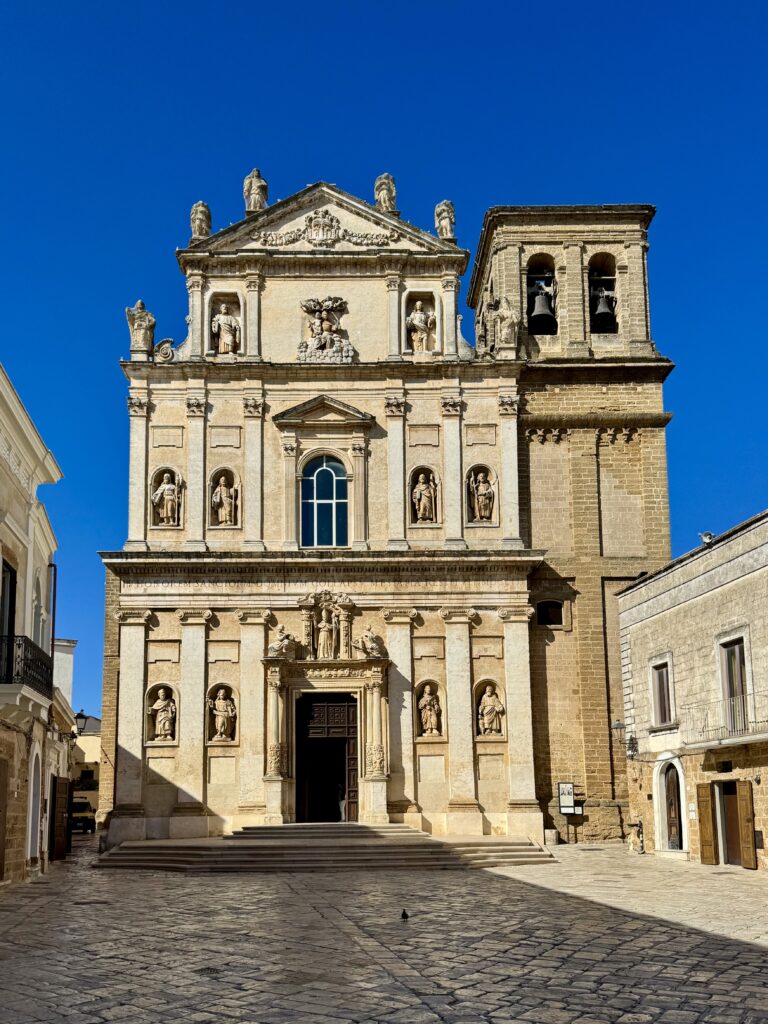
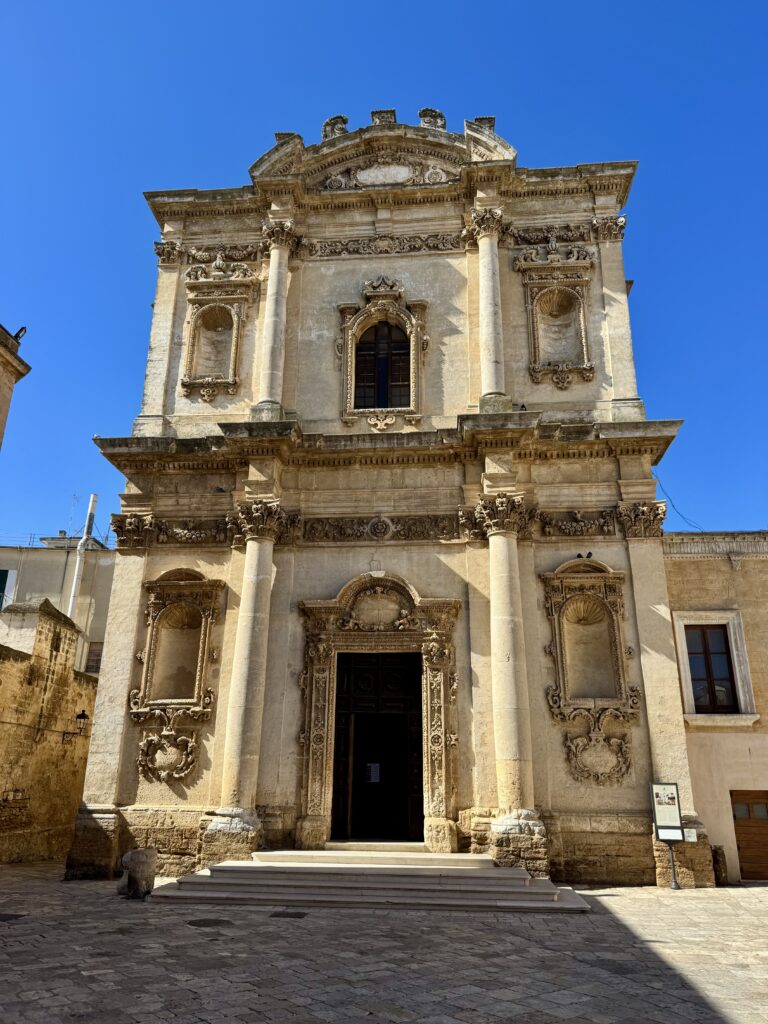
Between the 17th and 18th centuries, Mesagne — and especially its historic centre — underwent the transformation that shaped much of what we see today. It was a period of artistic revival, when churches and noble palazzi were rebuilt or richly embellished in the Puglian Baroque style.
Artisans from across the region, often working under the direction of the Mesagnese architect Francesco Capodieci, left behind façades of carved stone, elegant cornices, and swirling stucco interiors that still define the town’s character.
This short walking itinerary traces that legacy through the heart of the old town, visiting four of Mesagne’s most important Baroque churches:
- Chiesa Matrice — the grand mother church dominating Piazza IV Novembre
- Chiesa di Sant’Anna — a jewel of Lecce-style Baroque craftsmanship
- Chiesa di Santa Maria di Betlem — built in the early 1500s, later enriched with Baroque decoration
- Chiesa della SS. Annunziata, just beyond the walls, marking the edge of the old town
Each reveals a different facet of Mesagne’s Baroque period, from Capodieci’s refined architectural language to the exuberant sculptural decoration that swept through Puglia’s towns during this remarkable century of renewal.
Start your circuit at Porta Grande, the historic northern gateway into the old town. Step inside the walls and make your way first to the Castello Orsini–Del Balzo, whose courtyard offers a natural introduction to Mesagne’s medieval and Baroque layers.
From the castle, continue over Piazza Orsini to the Chiesa di Sant’Anna, its Lecce-stone façade one of Mesagne’s Baroque showpieces. Then walk back across the piazza (via Vico dei Cantelmo for the Complesso Archeologico di via Castello if you want to see the historic remains of the original settlements), across to the nearby Chiesa Matrice, whose imposing frontage anchors Piazza IV Novembre. Take a moment here — the square is one of the most impressive in the centro storico.
From the Chiesa Matrice, follow Via Albricci and turn into Piazza Commestibili, a small square lined with bars and restaurants. It’s a lively spot, especially in the evenings, and a good pause before continuing on to the Chiesa di Santa Maria di Betlem, just outside the old Porta Piccola.
After visiting Santa Maria di Betlem, head back into the centro storico. Walk up Via Geofilo, then turn right onto Via Felice Ronzini. But instead of following the road out of the small piazza area, keep to the left and follow one of the old town’s most photogenic streets, passing under a small arch that brings you around the side of Palazzo Savino and back onto Via Geofilo.
From here, return briefly towards Porta Grande, then follow the lane out towards the Chiesa della SS. Annunziata, the final stop on your itinerary. When you’ve finished, re-enter the old town through Porta Nuova, looping neatly back into the Baroque heart of Mesagne.
The entire walk takes around an hour at an easy pace, allowing time to step inside each church. Along the way, you’ll pass a handful of cafés and wine bars — perfect for a pause between stops.
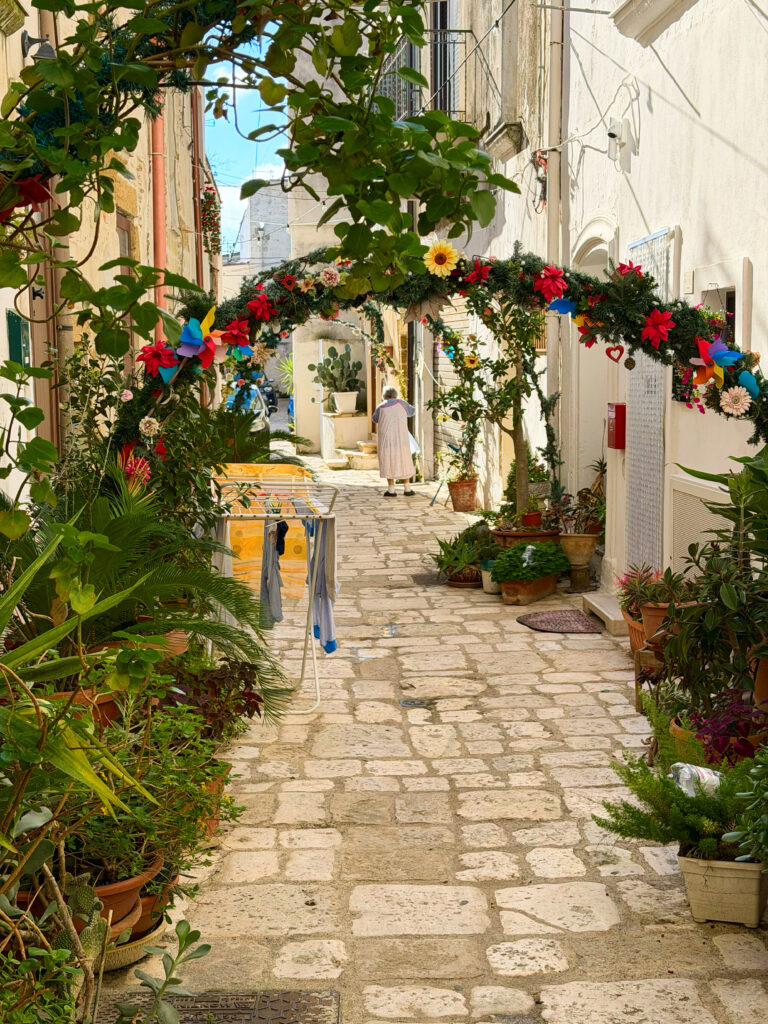

Or alternatively…
Given the relatively small size of the old town, it is possible to walk around, doubling up and down. Via the castle, Piazza Orsini and down Via degli Azzolino, continuing down Via Fiordeligi, turning onto Vico dei Caputo. Turn into Piazza Commestibili, then up Via Albricci to Piazza IV Novembre. From there head along Via Eugenio Santacesaria to connect with Via Geofilo. Follow that out of the old town to the Chiesa di Santa Maria di Betlem. From there you can pick back up our previous route so as not to miss out on that picturesque street along the other side of Palazzo Savino.
Palazzi & civic architecture
- Palazzo del Cavaliere, on Piazza Orsini del Balzo – handsome Corinthian pilasters and carved floral motifs.
- Palazzo Guarini, Via Eugenio Santacesaria – 16th-century home with an underground olive press still visible.
- Palazzo Monte di Pietà – former hospital and pawn bank; look for the inscription Hospitium pauper(um)(“hospital for the poor”) and the protruding iron cross once used as a public warning.
Messapian necropolises
For archaeology fans, Mesagne sits among some of Salento’s most important Messapian sites: Muro Tenente, Muro Maurizio and Muro Malvindi. Many finds are in the museum, but parts of the necropolises can be visited with a guide. Expect rock-cut tombs, fragments of pottery, and a sense of how deeply this land’s history runs.
Tours are arranged through the castle museum or local infopoint.
The Gates of Mesagne

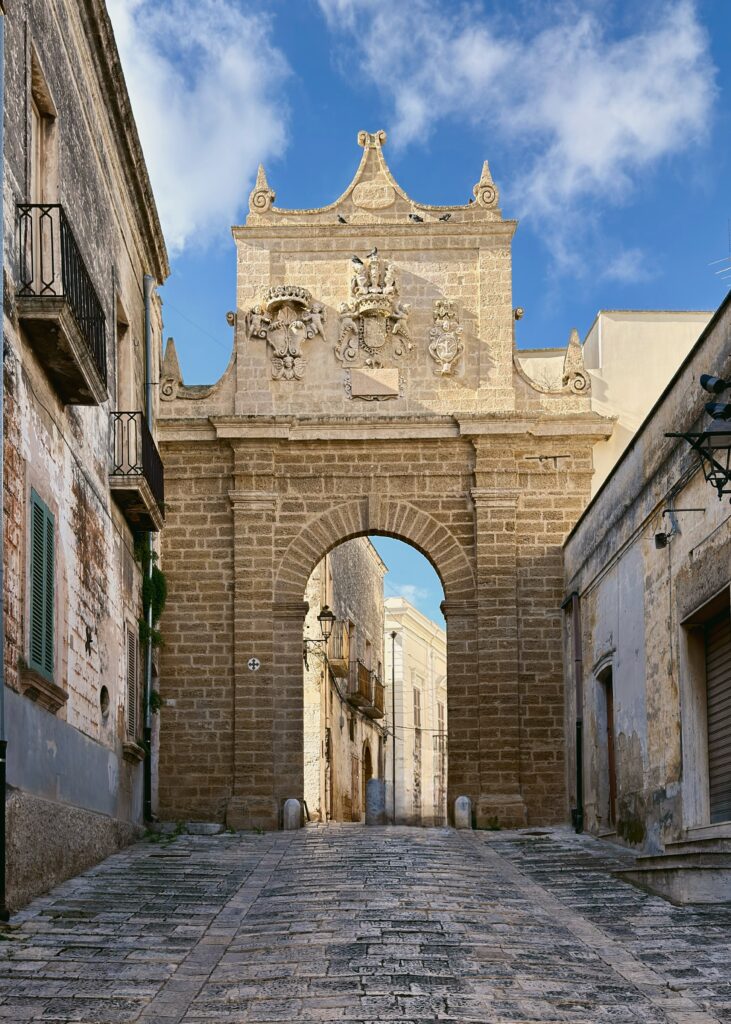
The defensive system of Mesagne probably dates to the first half of the 15th century, when Giannantonio Orsini del Balzo, Prince of Taranto, rebuilt the town as a fortified stronghold. The castle’s great torrione (keep) belongs to this same period. The historian Cataldo Antonio Mannarino, writing at the end of the 1500s, described a town surrounded by strong walls, reinforced by twenty-two turrets at regular intervals, and protected by two main access gates. His manuscript drawing — one of the earliest depictions of Mesagne — gives us a remarkable idea of the medieval layout.
Of the three original gates, only Porta Grande and Porta Nuova survive today, while Porta Piccola lives on in drawings and written descriptions. Together, they mark the evolution of Mesagne from a fortified medieval town to an expanding early-modern centre. The streets that once connected these gateways — now calm and pedestrian — still follow the same medieval geometry that made Mesagne such a strategic stop along the Via Appia Antica.
Porta Grande
Mesagne’s main gateway, the Porta Grande (also known as the Porta Boreale or di Napoli), is the most visible remnant of the town’s 15th-century defensive walls. Its current appearance dates from 1784, when Marquis Giuseppe Barretta, the town’s feudal lord, rebuilt it after a partial collapse twenty years earlier.
A 1993 restoration revealed that two different stones were used: a darker base, thought to be part of the original gate that survived the 1764 collapse, and a lighter upper section from the 18th-century rebuild. Look up to see the emblem of the Università (the old civic authority) and a noble coat of arms in the tympanum. In the Chiesa Matrice, the painting of Saint Oronzo includes an early depiction of the gate and its earlier triangular pediment.
Porta Piccola
The Porta Piccola (or Porta di Lecce) once opened on the south side of the town, leading towards the countryside and the road to Lecce. Mannarino’s 16th-century manuscript shows its position clearly, but sadly no trace remains. It was still standing in 1834, when the historian Antonio Profilo recorded its demolition due to its precarious state of repair.
Two sections of the medieval defensive system survive nearby. A circular turret is incorporated into buildings between Via degli Azzolino and Via Manfredi Svevo, while the base of a rectangular tower survives in a garden off Via Federico II, near the Chiesa della Santissima Annunziata. Beside it, a short stretch of the old wall can still be seen — one of the last visible fragments of Mesagne’s 15th-century circuit.
Porta Nuova
The Porta Nuova (or Porta Borghese, as locals called it) was built in the early 1600s to link the medieval core with a new residential quarter developing around the Dominican convent and the Chiesa di Santa Caterina. According to Profilo, the site chosen for construction was once a public cesspit, just inside the old walls. To make way for the new gate, the Università purchased and demolished several houses in the area, including some adjacent to Santa Caterina.
The gate was built during the mayoralty of Epifanio Ferdinando, a well-known local physician. Later, around 1702, it was rebuilt — probably due to instability — as confirmed by the Latin inscription still visible on the tympanum. This inscription names King Charles III of Bourbon and Prince Carmine De Angelis, the feudal lord at the time. Their heraldic shields appear above the arch: the royal crest of Charles III in the centre, the Barretta arms to the left, and the Mesagne civic crest to the right.
Profilo also notes that in the early 1800s, along what is now Via Martiri della Libertà (the street radiating from Porta Nuova), the ruins of an old church — possibly Santa Caterina — were still visible. During road-widening works in 1892, several tombs and frescoed wall fragments were uncovered here, perhaps belonging to the long-lost Chiesa di San Biagio.
The Castle and Museum
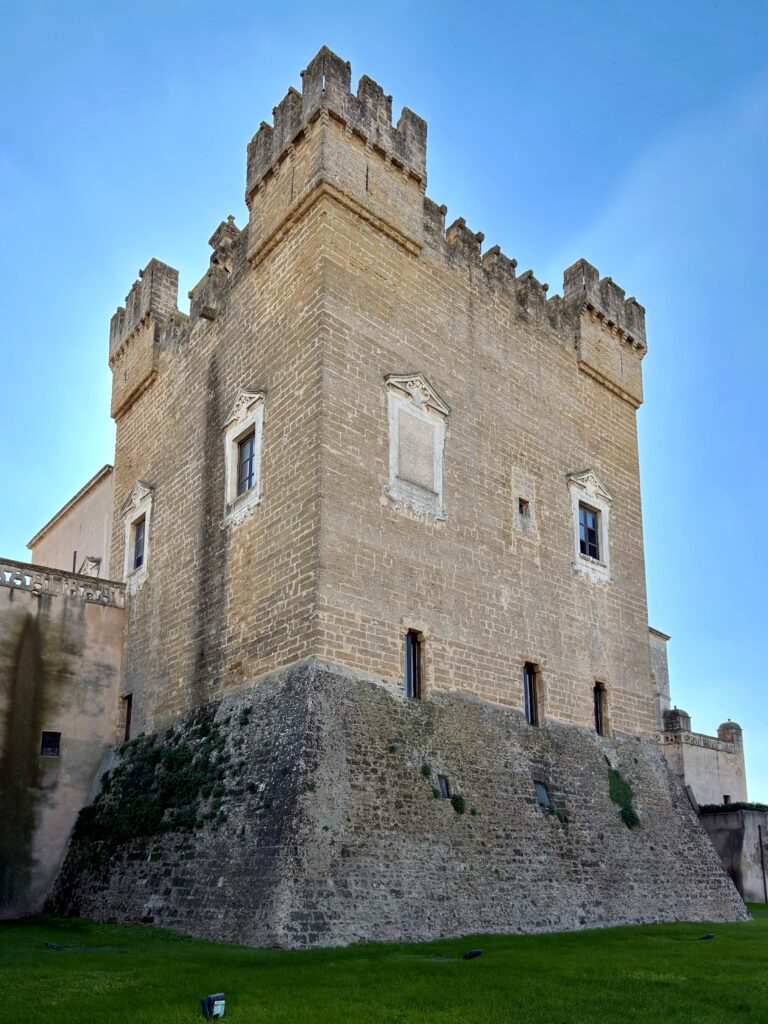
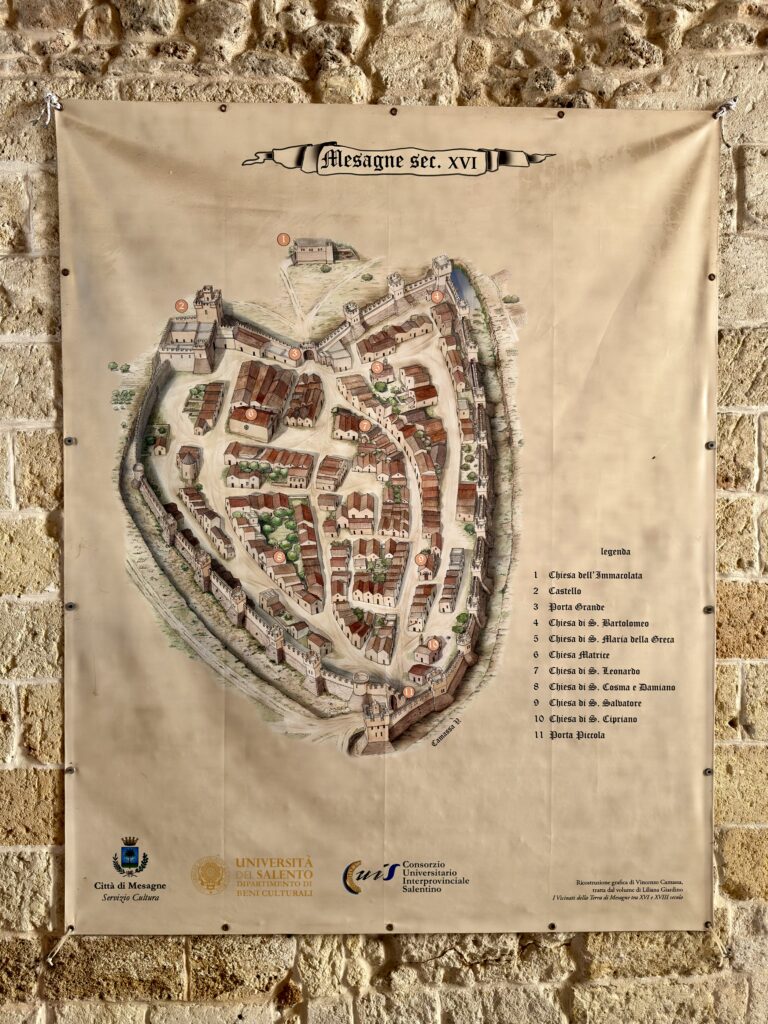
Immediately inside Porta Grande, to the right, stands the Norman-Svevo Castle of Mesagne, the city’s most imposing landmark. It is thought to have originally been built in the mid-11th century under the Norman leader Robert Guiscard, who led the conquest of southern Italy from the Byzantines and Lombards and, together with his brother Roger, seized Sicily from Muslim rule, later becoming Duke of Puglia and Calabria — though the earliest records remain uncertain.
The first reliable reference to the castle dates from 1220, when Emperor Frederick II confirmed Mesagne as property of the Teutonic Knights of Saint Mary of Jerusalem. The great torrione (keep) and defensive circuit were added in the 1430s under Orsini del Balzo, Prince of Taranto, who gave the town much of its late-medieval plan. The castle later became a baronial palazzo under the Albricci, De Angelis, Barretta and Imperiali families.
In 1973, the castle was acquired by the Municipality of Mesagne and was later carefully restored. Today it houses the Museo del Territorio “Ugo Granafei”, one of Puglia’s earliest civic archaeological museums. Exhibits span from the prehistoric and Messapian eras to the Roman and medieval periods, including a beautifully reconstructed aristocratic tomb discovered nearby. The castle also serves as a venue for concerts, lectures and summer cultural events — making it both a monument and a lively community space.
You can explore the courtyard and ramparts freely, or visit the Museo del Territorio “Ugo Granafei” (€3 entry). The museum — one of Puglia’s oldest civic collections — spans the Iron Age to the Middle Ages, with highlights including a reconstructed Messapian tomb, grave goods, pottery and ornaments from local archaeological sites such as Muro Tenente, Muro Maurizio and Malvindi. The exhibition also includes tactile displays designed for blind and partially sighted visitors.
Visiting the Castle and Museo del Territorio “Ugo Granafei”
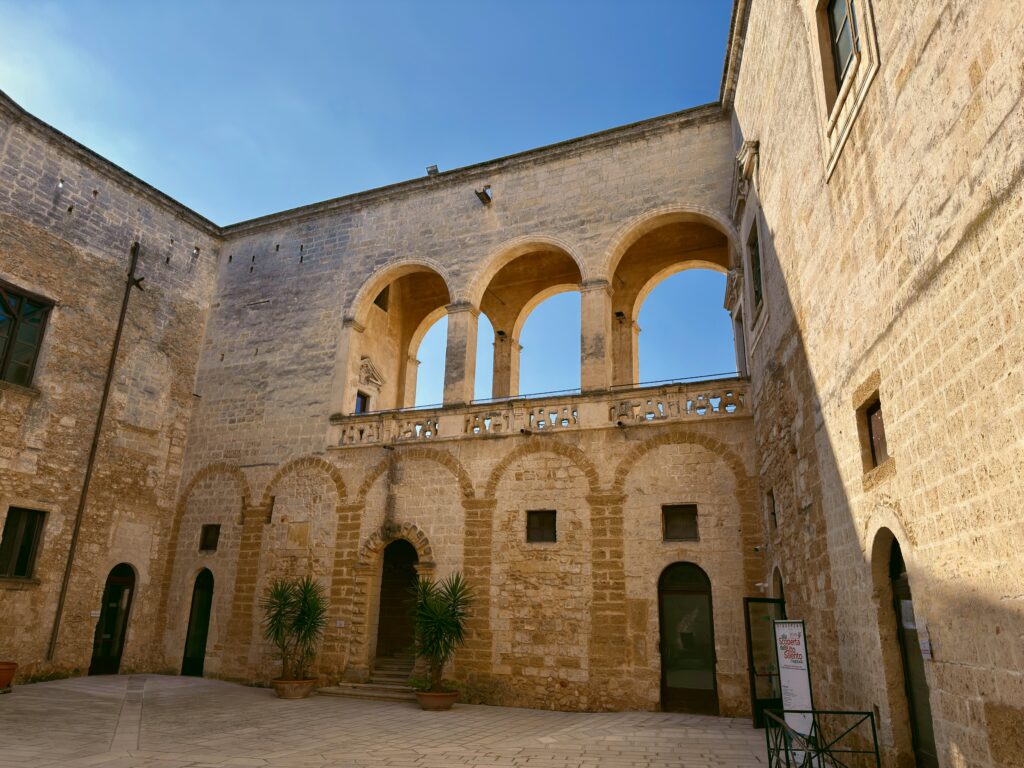
Look for:
- The Norman tower, still showing its arrow slits and the castle’s oldest surviving structure, dating to the 15th century.
- The courtyard loggia added in 1661 by Prince Giannantonio Albricci — note the floor mosaic.
- The underground neviere, wood-lined ice stores once packed with snow from the Murge.
- The old prison, six cells reached by steep stairs.
- The Great Hall, once used for banquets, now displaying frescoed coats of arms.
Opening Hours:
Usually Tuesday–Sunday, mornings and late afternoons. Closed Mondays.
Good to Know:
- Signage is in both Italian and English.
- The museum is compact but well presented — allow 45 minutes to 1 hour for a visit.
- In summer, evening openings often coincide with concerts or cultural events in the courtyard.
Chiesa Matrice (Mother Church of All Saints)

The Chiesa Matrice is Mesagne’s main church and one of the most beautiful examples of Leccese Baroque architecture outside Lecce itself. It stands in the town’s most lived-in quarter and owes its present form to the Mesagnese architect-cleric Francesco Capodieci, who rebuilt it in the mid-1600s after an earlier structure collapsed.
An earlier church may have stood here as far back as the 14th or 15th century, possibly under Roberto d’Angiò or Giannantonio Del Balzo Orsini, though there’s no firm evidence. Local records instead trace three main phases of work. The first came in the late 1500s, when the choir and sacristy were enlarged. The second, between 1649 and 1660, saw Capodieci’s complete redesign, supported by the De Angelis family, whose influence also reshaped the nearby Chiesa di Sant’Anna, the square opposite, and the baronial palace. By 1670 the new church was complete, with its wooden choirand painted side altars by the local artist Gianleonardo Cunavi.
The third phase, following the earthquake of 1743, gave the church much of its current appearance. The vaulted ceiling was designed by Giuseppe Palmieri of Monopoli, and master plasterers from Naples created the ornate stuccoes and marble altars, while Mesagnese craftsmen built the wooden fittings. The organ, completed in 1777 by Giovanni Valle, still crowns the choir loft today.

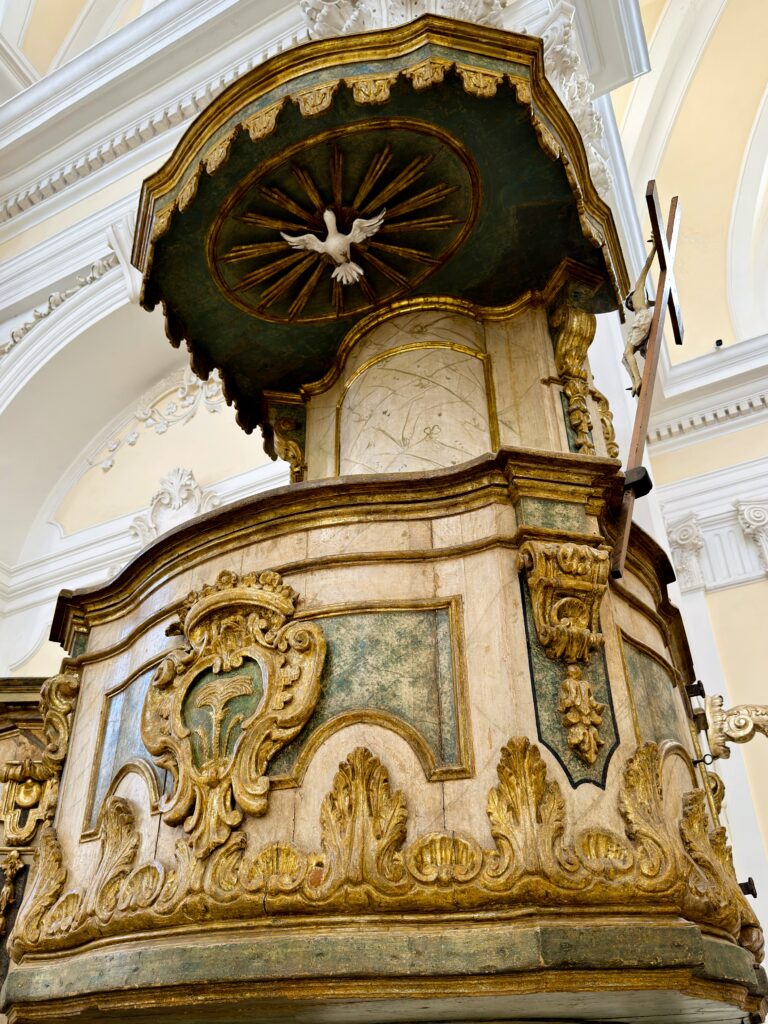
Outside, the façade is a textbook study in Puglian Baroque: three tiers of Ionic, Corinthian and Composite pilasters, niches with saints and city emblems, and statues of Saint Oronzo, Antea and Coroebus above the main door.
Inside, the church follows a Latin-cross plan with a single nave lit by tall windows. A cupola rises above the crossing, and below the sanctuary lies a crypt, reached by a graceful stone stairway. The carved wooden choir stalls are unique in Mesagne, having survived when others in the town disappeared.
Among the highlights are the canvas of Saint Oronzo Protecting Mesagne, showing how the town once looked in the 1600s, and paintings by Zullo, Cunavi, Pinca, Bonito and Lillo, whose Assumption of Mary (1772) glows with colour and light.
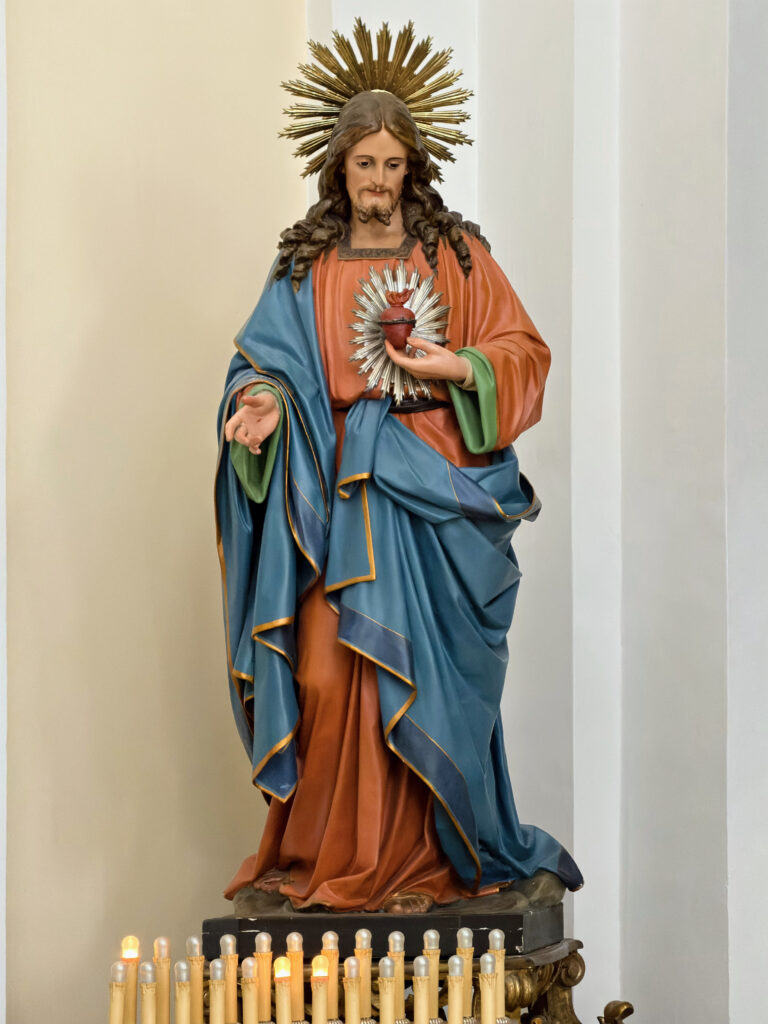

Chiesa di Sant’Anna
A short walk from the Chiesa Matrice brings you to the Chiesa di Sant’Anna. Built between 1683 and 1699, the church is another of Mesagne’s finest Baroque landmarks and the last great work of the local architect-cleric Francesco Capodieci. He designed it for Vittoria Capano, widow of Prince Niccolò De Angelis, who vowed to build a church to Saint Anne in thanks for the recovery of her son Carmine. Capodieci died before the project was finished, and it was Carmine himself who later oversaw its completion and commissioned the altarpieces.
The façade, in creamy Leccese stone, was sculpted by Pietro Elmo and Giuseppe Cino, two masters of the Salento Baroque. It is divided vertically into three sections with double columns and half-pilasters, and four niches that may once have held the Evangelists. A richly carved portal with cherubs and a curved pediment bears the date 1699 at the top. Together, Capodieci’s design and the stonemasons’ artistry created one of the most elegant Baroque façades in Puglia.
To make room for the new church and its piazza, part of the 15th-century city wall and an entire block of houses were demolished — a bold move that reshaped the heart of Mesagne. The result is a balanced composition of architecture and open space, deliberately designed to rival the nearby Collegiata (the Chiesa Matrice) in beauty and prominence.
Inside, the church is simple but graceful, with a single nave, vaulted roof, and two side altars. Wooden women’s galleries from the 17th century survive above the aisles, while two small doors flank the main altar — one leading to the sacristy and the other once connecting directly with the baronial palace.
The high altar, of stone covered in painted stucco, holds a canvas of the Nativity, with Saint Anne and Saint Joachim beside Mary and Joseph. Other works include a Crucifixion with Saint Francis and Saint Catherine of Siena, and a Deposition after Veronese, possibly painted by Andrea Cunavi or Giacomo da San Vito.
Chiesa di Santa Maria di Betlem

Just outside the former Porta Piccola, the Chiesa di Santa Maria di Betlem has been tied to Mesagne’s monastic history for centuries. The original 16th-century church fell into disrepair by the early 1600s, when the Celestine Fathers took it over from the Benedictine monks. Work on the present building began around 1660, probably under the supervision of Francesco Capodieci, who had just completed the new Collegiata (Mother Church). Together, these two buildings marked the arrival of the Baroque style in Mesagne.
The adjoining Celestine monastery was expanded in 1711 and again in 1738. The Leccese sculptors Pasquale and Domenico Antonio Simone were likely responsible for much of the church’s later decoration — its sculpted façade, side altars and vaulted ceiling.
Inside, the church has a single nave lined with Baroque side chapels, each with paintings from the early 18th century. Highlights include the altar of Saint Peter Celestine, with a canvas of the saint and a small fresco of Our Lady of Health; the Chapel of the Crucifixion, with its dramatic depiction of Christ on the Cross; and chapels dedicated to Saint Vitus the Martyr, Saint Benedict, and the Madonna of the Snow, each richly decorated with devotional paintings.
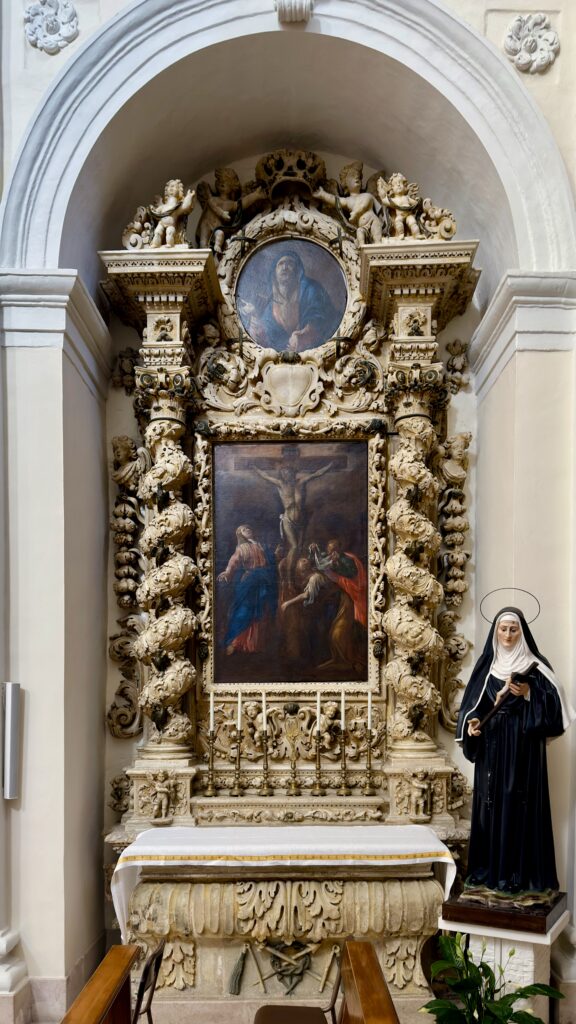
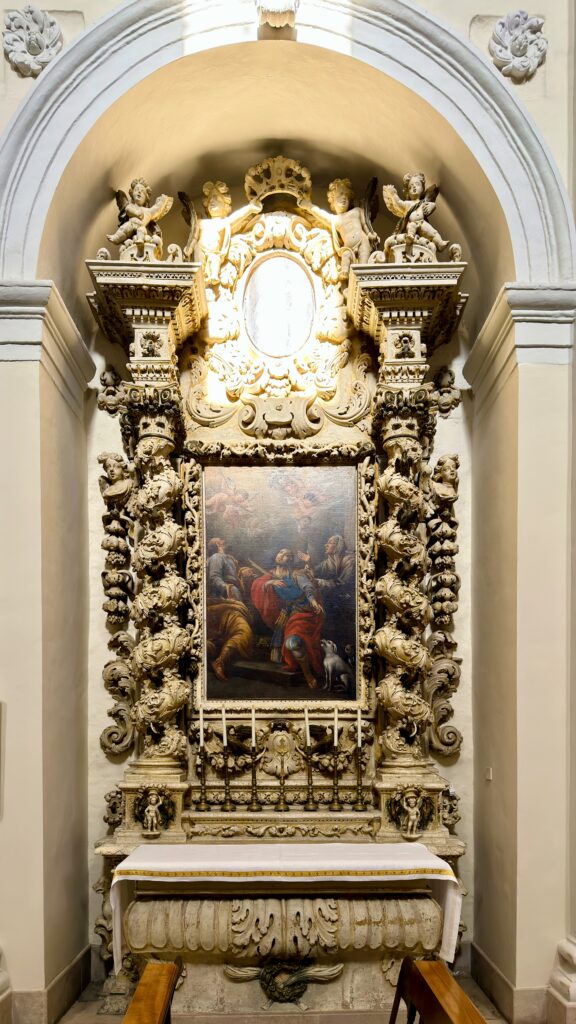

The main altar, in polychrome marble, stands beneath an elegant organ gallery carved in wood. Two large canvases in the presbytery deserve special attention: an Adoration of the Shepherds, distinctly Baroque in style with Venetian and Neapolitan influences, and an Adoration of the Magi, attributed to the Mesagnese painter Lucantonio Paciolla, whose more restrained 16th-century composition contrasts beautifully with the later works around it.
The façade, arranged in two tiers, rises to a central pediment flanked by angels and pinnacles. The lower level features statues of Saint Benedict and Saint Peter Celestine, while the upper order holds Santa Scolastica, Santa Gertrude and other saints, with a richly framed window in the centre. Above the entrance stands a statue of the Vergine della Sanità (Our Lady of Health), echoing the design of the Chiesa Matrice, and in the pediment, a relief of Saint Michael the Archangel.

Chiesa della SS. Annunziata
The Chiesa della Santissima Annunziata stands just beyond the old town walls and marks the southern edge of Mesagne’s Baroque heart. The first stone was laid on 16 October 1701, in the presence of Archbishop Barnaba de Castro of Brindisi, to designs by the Leccese architect Giuseppe Cino, one of the leading figures of the Salento Baroque. The work was carried out by the Capozza family of Lequile, who completed the walls and elevation by 1715.
Cino’s original plan called for a wooden roof, but the Dominican friars, who owned the church and adjoining monastery, later insisted on a vaulted ceiling instead. The vault was built between 1716 and 1729 by the architect Angelo Guido and his sons, Francesco and Donato.
The earthquake of 1743 caused severe damage throughout the region, including here. The Dominicans commissioned the engineer Pasquale Margoleo to rebuild parts of the monastery and church, a task completed in 1750. The result is the structure we see today — octagonal in plan, vaulted in stone, but never fully completed: the façade was left unfinished, and the bell tower was never built.
Following the suppression of the Dominican Order in 1809, the church was transferred to the Confraternity of Saint Leonard and reopened for worship in 1848. The façade, divided into two registers, remains simple and slightly irregular: the upper level, with its central window and flanking Baroque niches, was never finished.
Inside, the church has a single wide nave set within an irregular octagonal layout, surrounded by eight side chapels. It holds several notable 18th-century artworks, including a wooden statue of Saint Leonard the Abbot and paintings by Saverio Lillo of Ruffano, Gian Pietro Zullo, and Domenico Pinca, all part of Mesagne’s proud local painting tradition.
One of the most remarkable elements, however, predates the church itself. The portal of the earlier 16th-century church, carved in 1555 by the Nardò sculptor Francesco Bellotto, was preserved and incorporated into the rear façade. Crafted from carparo stone, it displays exquisite Renaissance detail: a city crest, a frieze showing a triumphal procession and the Veil of Veronica, and sculpted figures of the Virgin of the Rosary, Saint Dominic, and Saint Catherine, flanked by the Annunciation scene and topped by a delicate rose window.


Palazzi and Museum of Sacred Art
Among Mesagne’s noble residences, Palazzo Cavaliere (now the Museum of Sacred Art Cavaliere–Argentiero) stands out for its collection of silverware, vestments and devotional objects from the 16th–19th centuries. Also note Palazzo Guarini, with its underground olive mill still intact, and Palazzo Monte di Pietà, which once served as a hospital for the poor and later the town hall.
Parco Archeologico di Muro Tenente
A 10-minute drive west of Mesagne lies one of southern Puglia’s most important Messapian sites. The Parco Archeologico di Muro Tenente preserves the remains of a fortified settlement that controlled the final approach of the Via Appia Antica towards Brindisi. Its massive walls — up to 6 metres thick and still standing 3 metres high in places — enclose about 50 hectares. Within the enclosure, excavations have revealed dwellings, pottery kilns, and a 3rd-century BC Messapian house reconstructed on site.
Marked trails and bilingual panels help visitors interpret the fortifications, while special events and guided tours in summer explore the site’s links to the Appian Way and the wider Messapian civilisation. Here you can quite literally walk the last Roman miles before the Adriatic — a powerful reminder that Mesagne’s story began as a crossroads of ancient routes.
The Puglia Guide | How we review
We don’t accept payment, discounts, or freebies in exchange for coverage or recommendations. Every meal, stay, and experience featured in our guide is paid for in full and visited anonymously, so we receive the same treatment as any other traveller. Our opinions are based entirely on first-hand experience.
Eat & drink

Evenings start slowly here. Locals stroll, cafés fill, and the centro hums with conversation. Stop for an aperitivo on Piazza Orsini del Balzo or a glass of Primitivo under the arches of Piazzetta dei Caniglia.
What’s on the table
Mesagne’s cooking follows the seasonal rhythm of the land. Dishes have a distinct Salento influence — horse meat is not uncommon — while drawing inspiration from elsewhere in our region. Here you will find the same plate of pasta served with cime di rapa and cozze tarantine, a delicious mix of surf and turf, focaccia pugliese, topped with cherry tomatoes and olives, panzerotti fried to order, bombette, and grilled seafood brought in from the Adriatic and Ionian.
Pair it with wines from the Brindisi hinterland — Primitivo, Negroamaro, or Malvasia Bianca.
Where to eat
Mesagne’s old town is packed with both traditional and trendy restaurants and bars. It is vibrant and exciting, but so much calmer and peaceful compared with better known Puglia destinations.
Osteria del Vicoletto, just a few steps from Porta Grande. It’s small, atmospheric, and consistently excellent — with fresh seafood, creative antipasti, homemade pasta and well-cooked meat dishes. The wine list is short but superb, and prices are refreshingly modest for the quality.
We had some amazing spaghetti with seasonal cime di rapa and cozze tarantine, the famous Taranto mussels (which was recommended off menu) at Soffuso Ristorante, just a few steps away from Palazzo Savino. It was a delicious and inspired mix of terra e mare, land and sea.

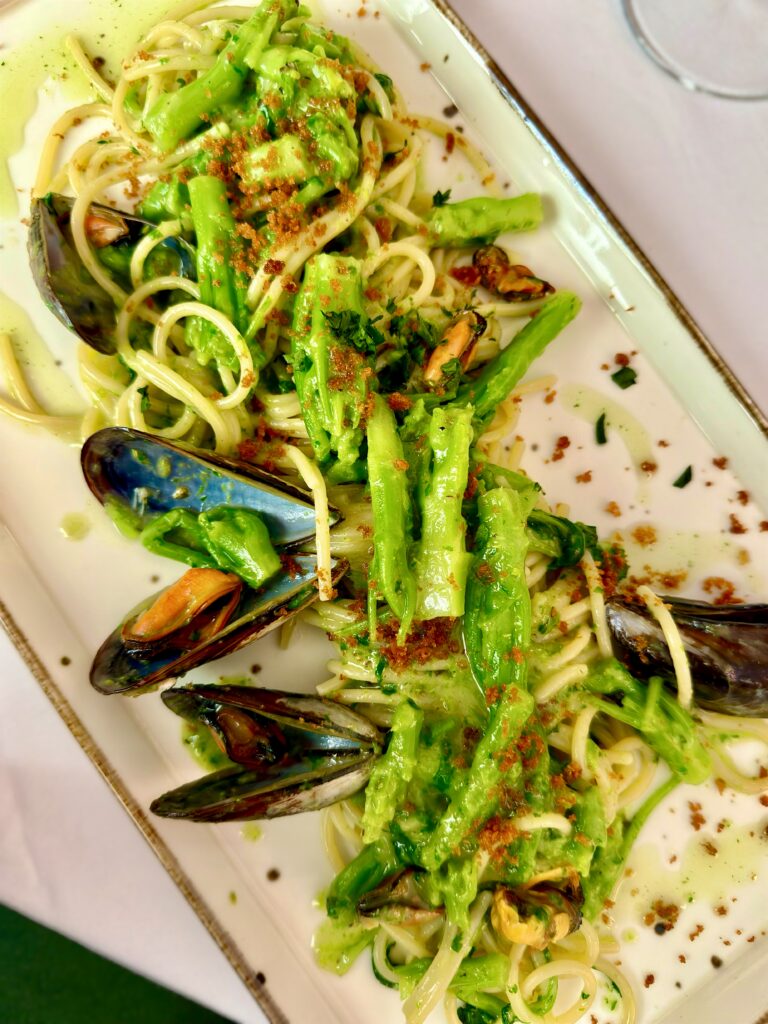
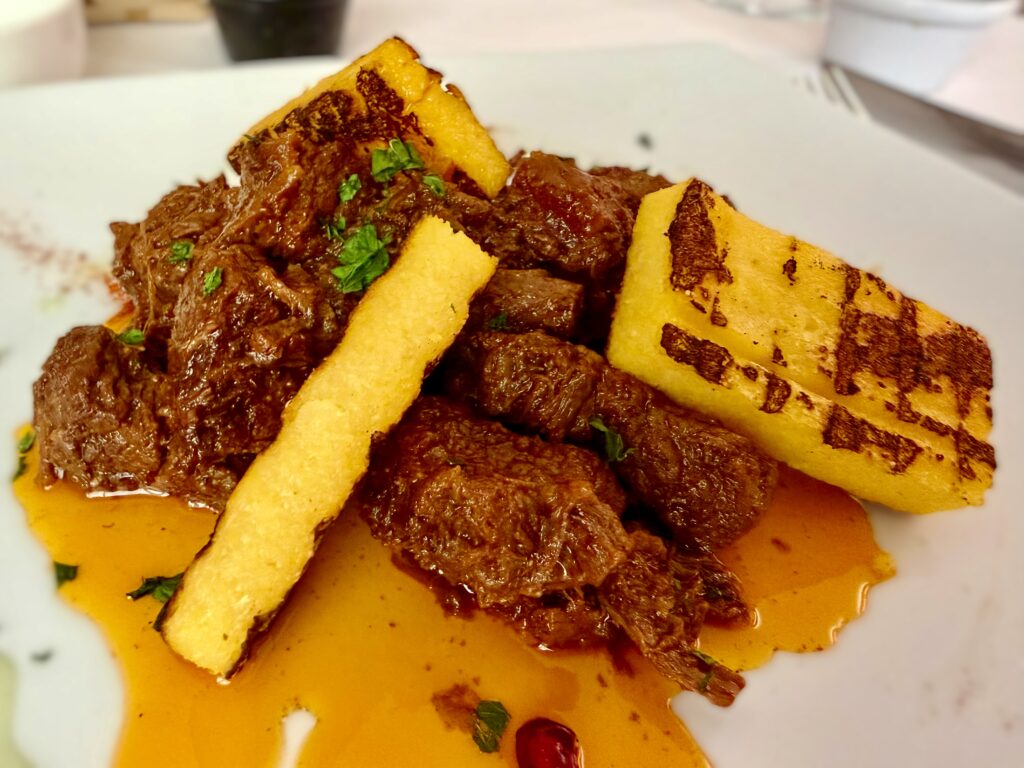
For our main, we chose cavallo — horse meat — served with polenta. While it’s a dish that may not appeal to all tastes, it remains an important part of Salento’s culinary tradition. For generations, horse and donkey meat were valued for their rich flavour and high quality, especially in rural communities where nothing was wasted. Even today, specialist equine butchers can still be found across the region, a reminder of this enduring local heritage.
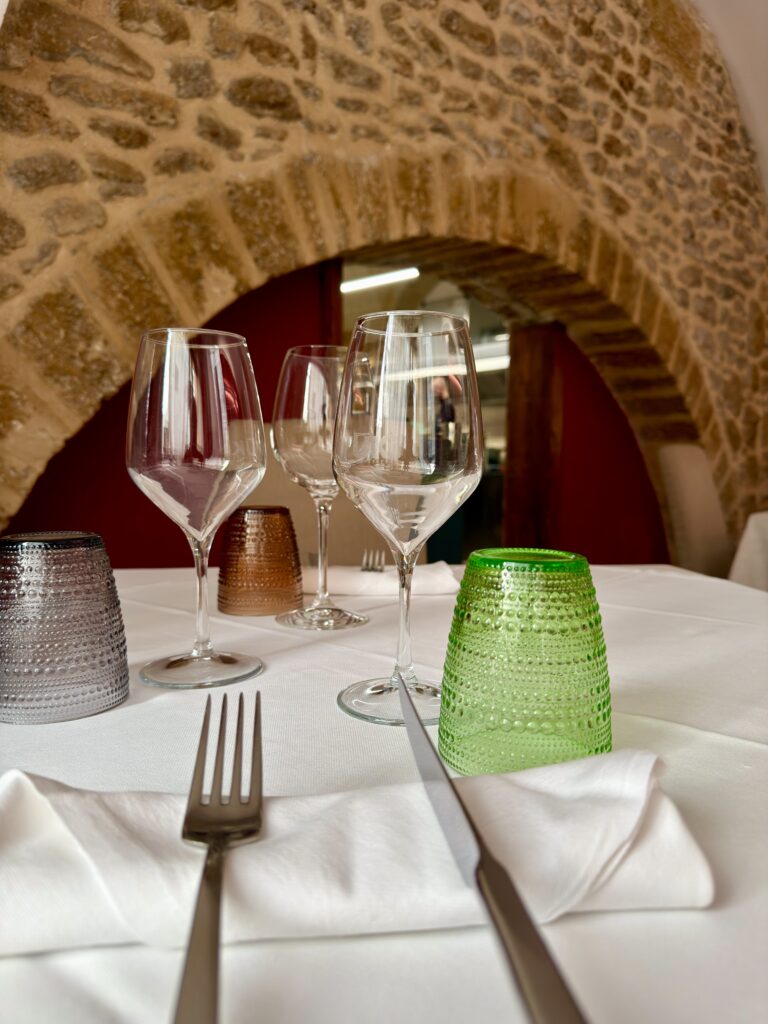
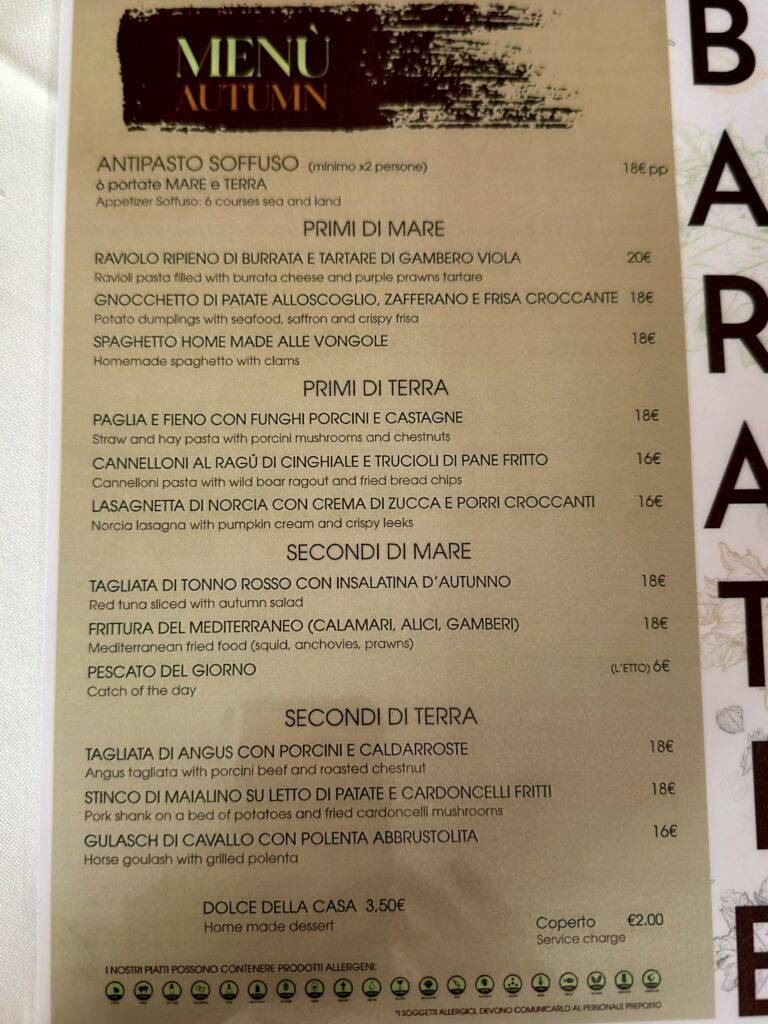

D’Alé is a reliable choice. Known for its seafood offering, although other dishes are also on the menu. Some outdoor seating, but be aware that the narrow road is open to resident traffic.
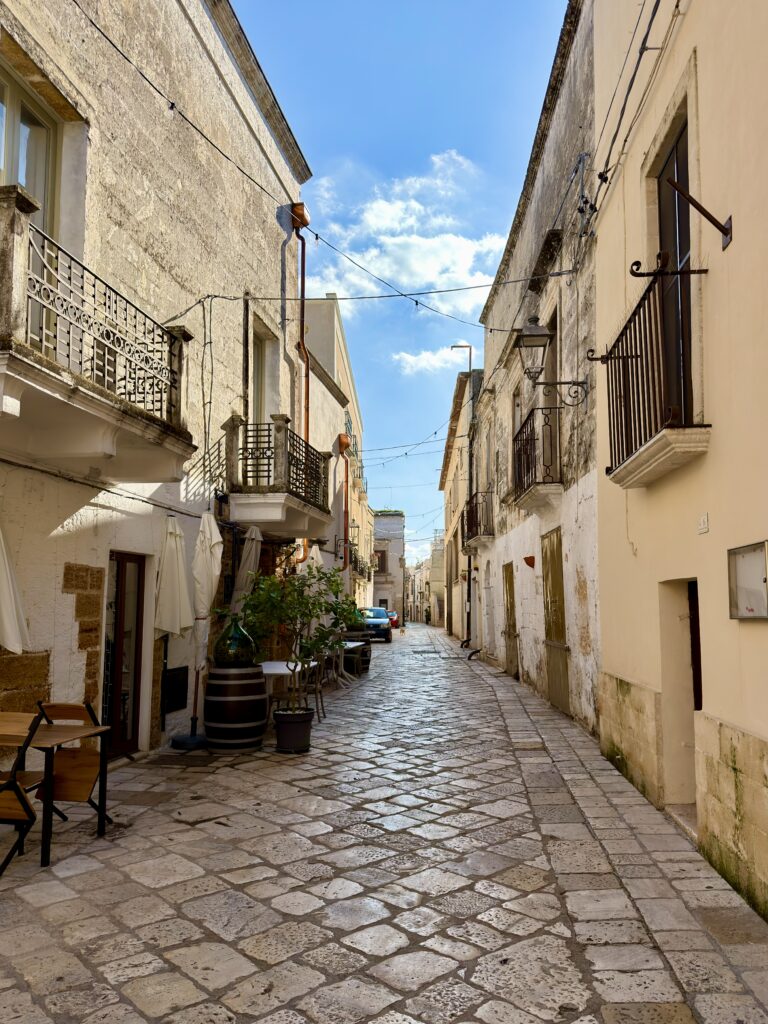

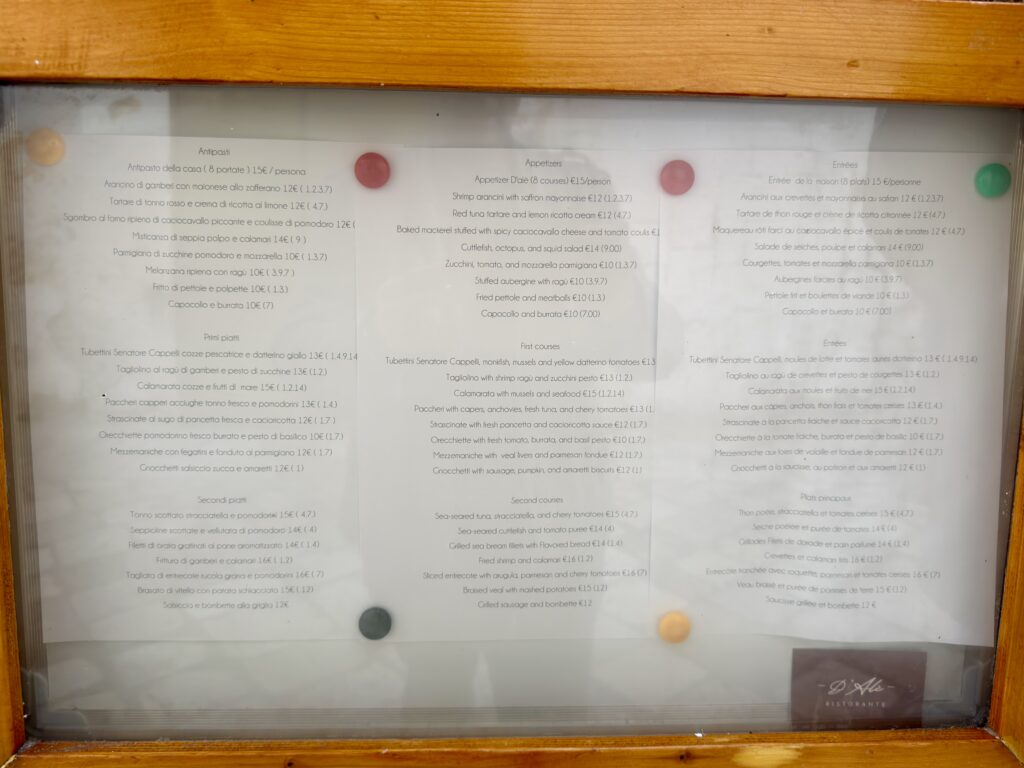
For meat lovers Mangiafueco to the side of Piazza Orsini is an interesting braceria grill with an innovative menu.


Other restaurants to look out for include the very excellent Guidamino, with an attractive terrace out front. It does get busy, but the hospitality is warm and welcoming. Benvenuti al Sud is a local favourite.
Where to stay
In town
Boutique B&Bs and apartments line the old lanes — ideal if you want to wander to dinner and feel part of local life.
Our favourite stay at is Palazzo Savino. Dating from the 18th century, this elegant townhouse has been lovingly restored over a four-year project, reopening in June 2024. The renovation preserves its architectural integrity while introducing a quiet contemporary luxury.
Rooms are arranged across three floors — King Suite, Deluxe and Superior — each individually designed, with thoughtful details such as 1940s silk wallpaper and bespoke furnishings that reflect the palazzo’s layered history.
Inside, traditional Salento star-vaulted ceilings and an imposing marble staircase set the tone. Above, two rooftop terraces offer contrasting moods — one an intimate Liberty-style retreat, the other opening out over Mesagne’s historic centre.
Palazzo Savino is perfectly located in the heart of Mesagne’s old town, and is an exceptional hotel that’s one of the Epoca Collection of exclusive boutique hotels and masserie in Puglia. The rooms are beautiful, the service attentive.
We stayed in the Deluxe King Suite, which was glorious. Rooms facing Via Geofilo can pick up noise from the street below. The road is narrow, and tall buildings on either side amplify and reflect sound. Our visit was on 11th November, when we celebrate San Martino and the arrival of vino novello. The restaurant opposite — which also serves as a bar — played music until around midnight. Early to bed, light-sleepers may prefer a room on the palazzo’s other side.
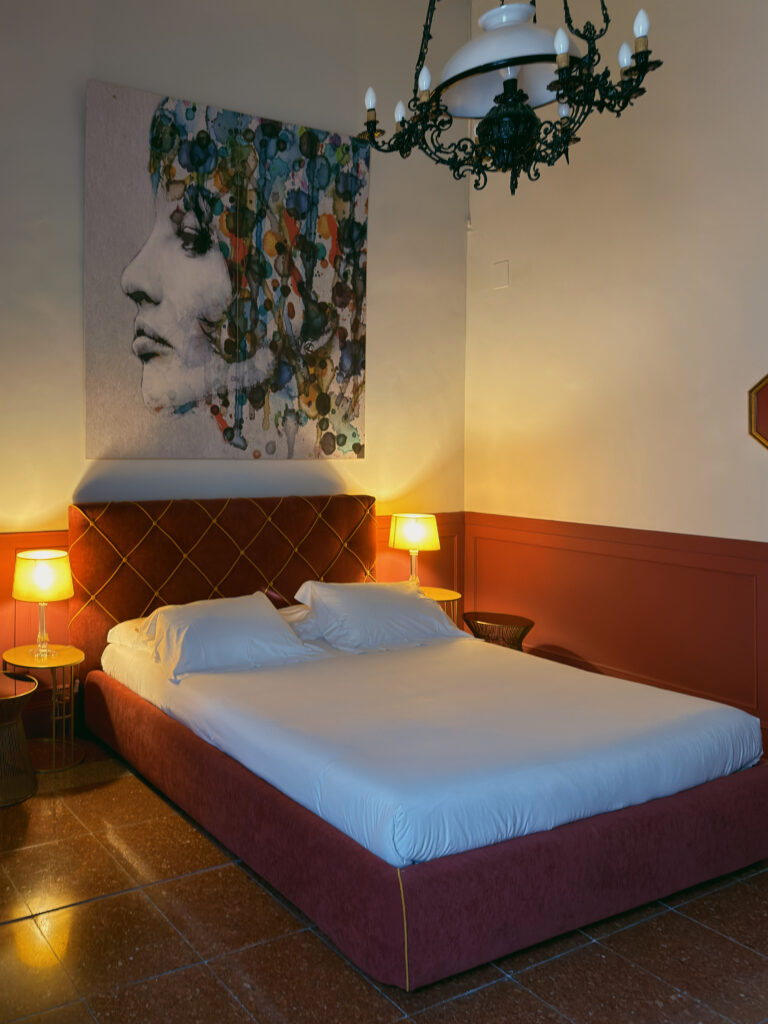

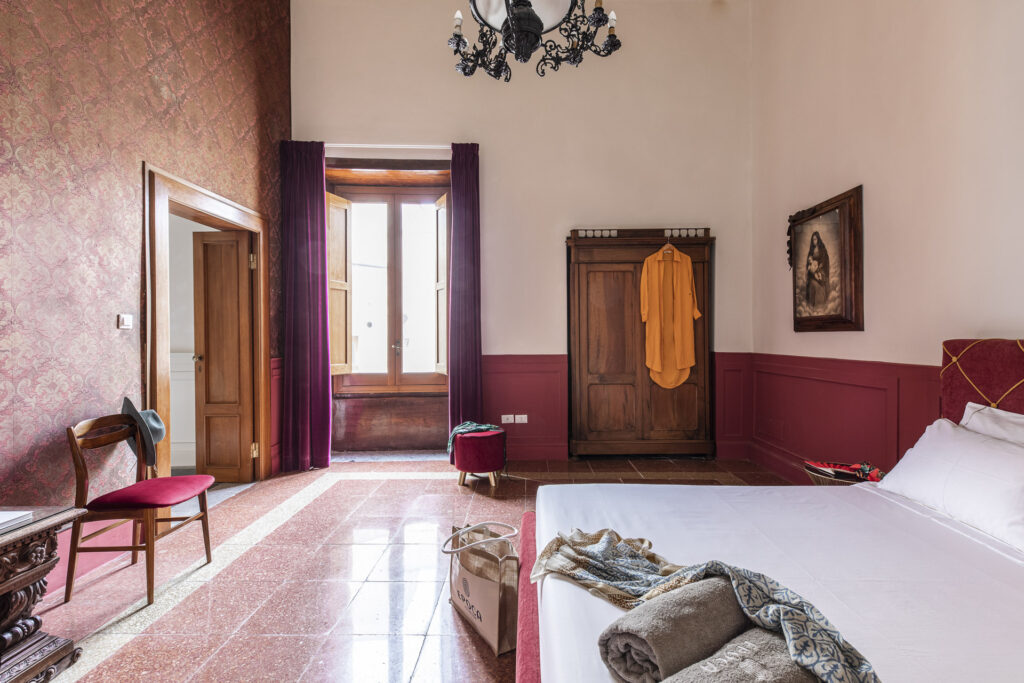
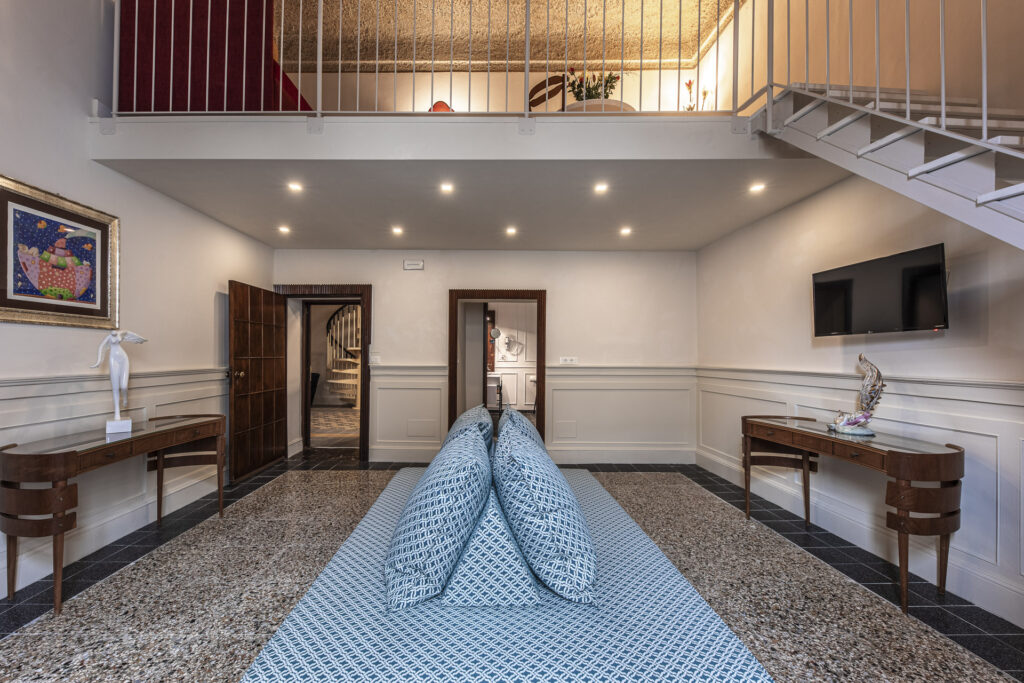

A generous breakfast, included in our room rate, was served in the beautifully decorated dining room. We selected in advance, from a wide choice of continental options, cereals, fruit juices and local pastries.
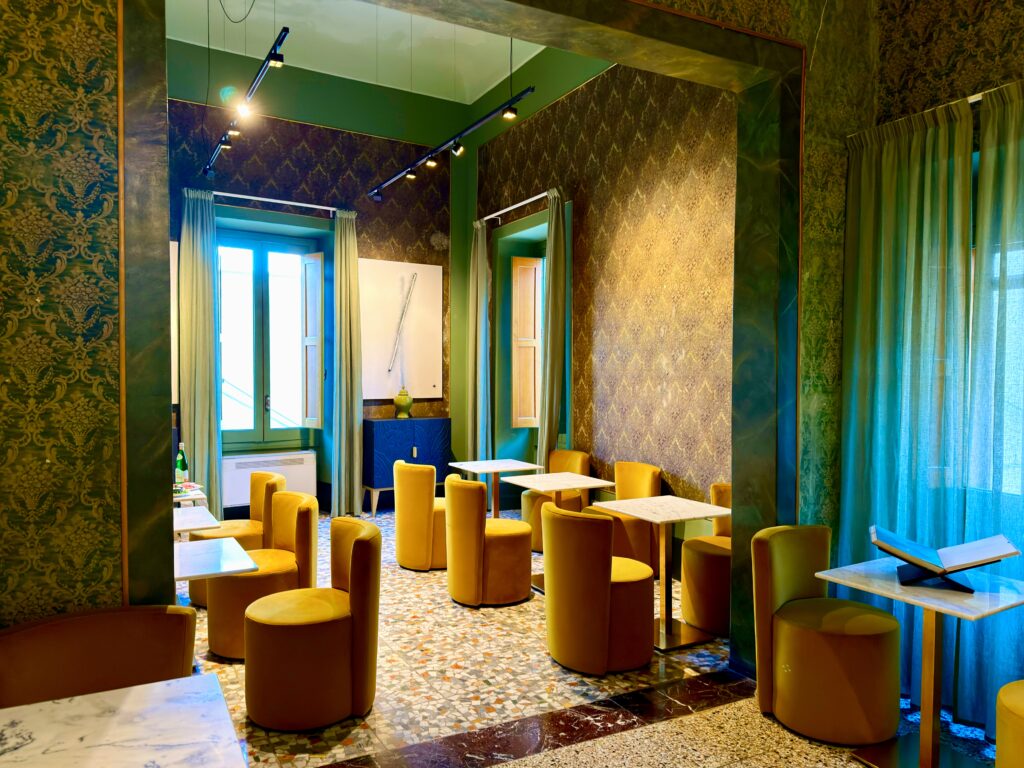
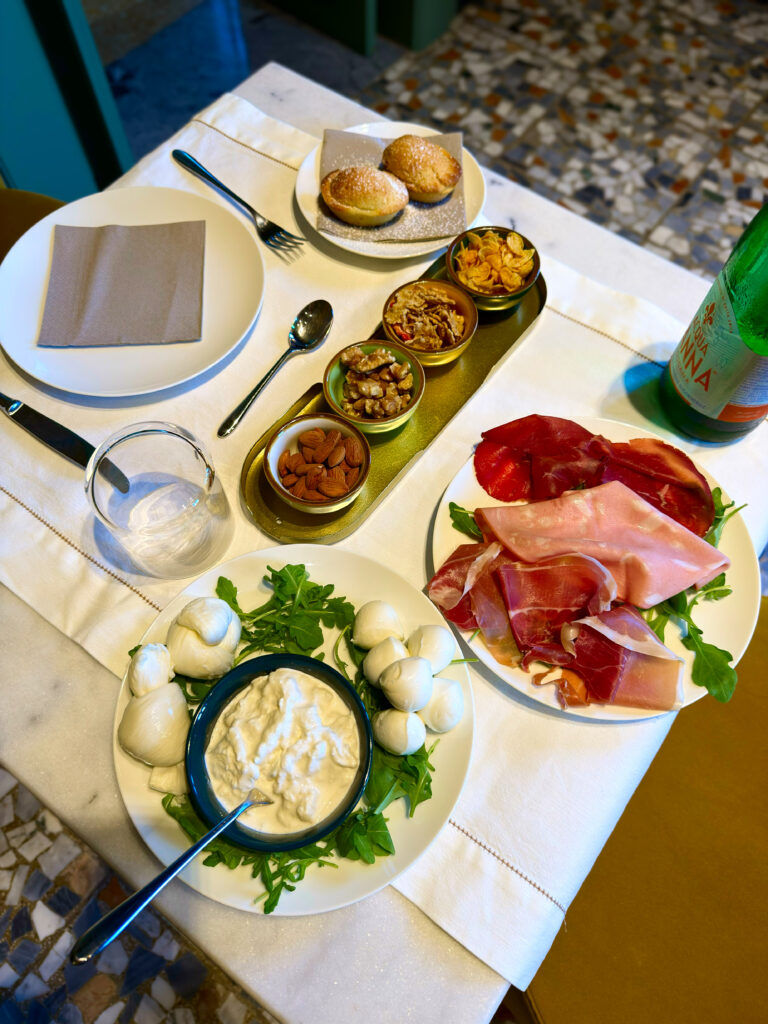
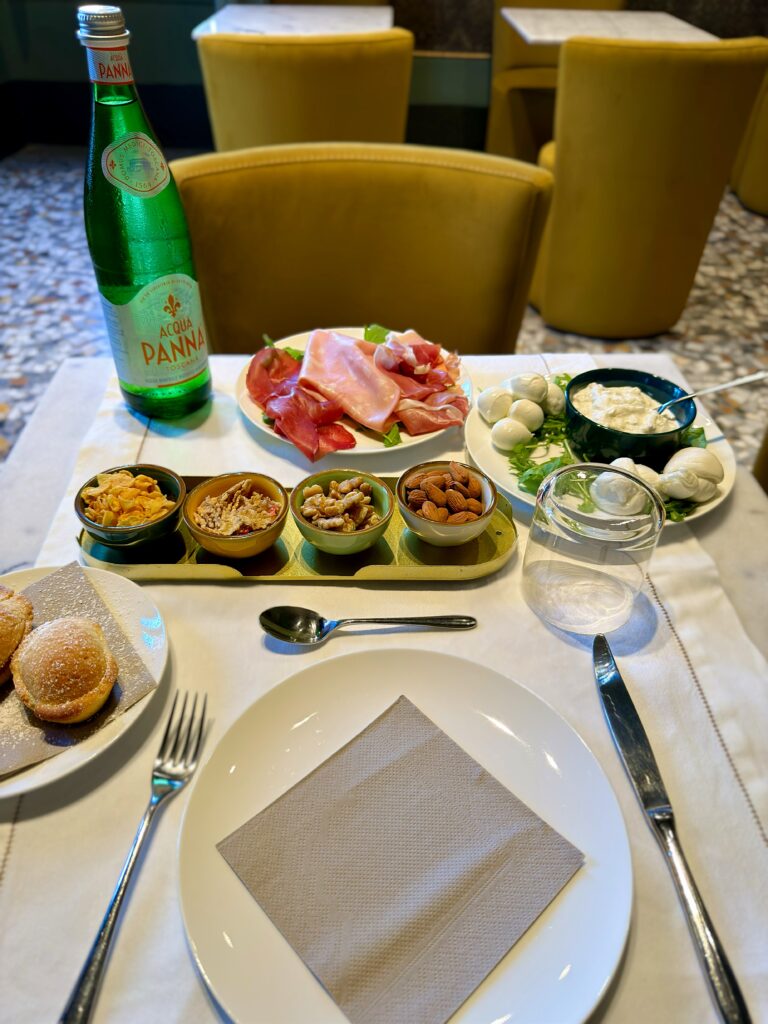
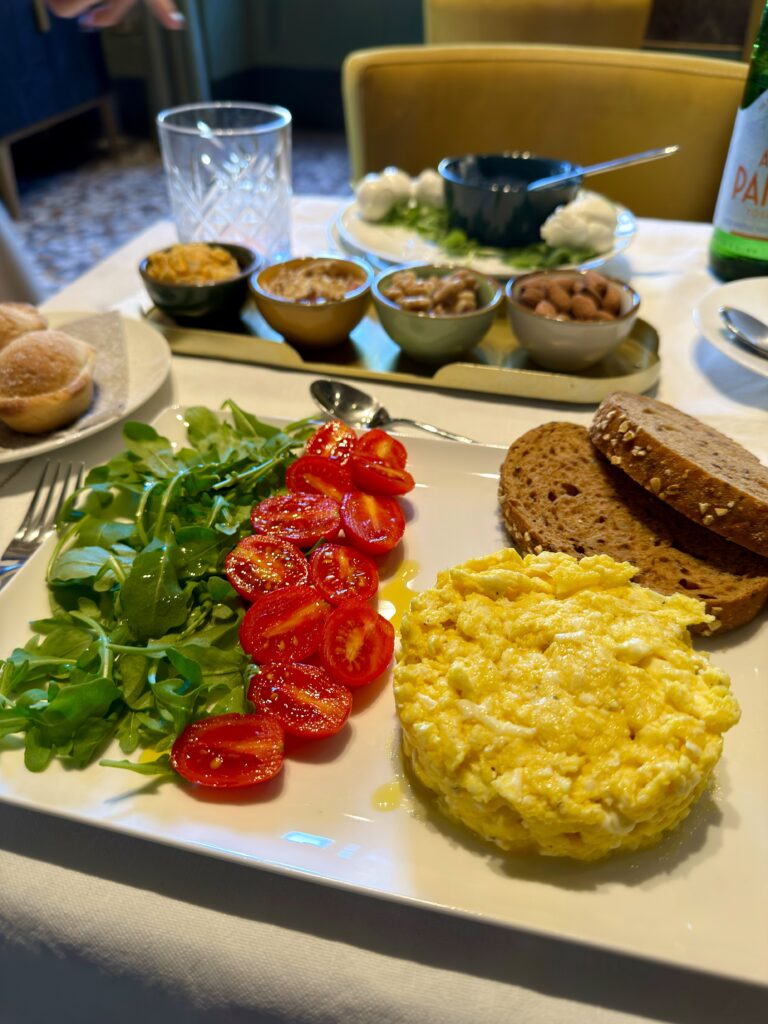

In the countryside
Around Mesagne you’ll find masserie and agriturismi offering quiet stays among olive trees, farm-to-table food, and in some cases, the chance to join in with olive picking or the grape harvest.
Our tip: stay inside the walls if you want atmosphere; outside for space and parking.
Festivals & events
Mesagne has a bustìy festival calendar.
- Patronal feasts – on 16 July the town celebrates its patron saint, Madonna del Carmine, with luminarie, marching bands, fireworks, street food.
- Fashion Mesagne / Mesagne in Moda & Show – a local event that showcases young and established designers, brands, and local companies, held at the end of June.
- Carnival – February parades with floats and costumes.
- Christmas – Christmas lights are on display from December through early January; Porta Nuova and the main streets sparkle. The Pro Loco of Mesagne and the Fidas association organise an annual presepe vivente — living nativity — running from 27 December to 6 January. The procession, featuring characters in period costume, winds through the historic centre and municipal villa, recreating the journey of the Three Kings. The event culminates in adoration at the nativity scene.
Getting there & around
By train
Train station & getting into town
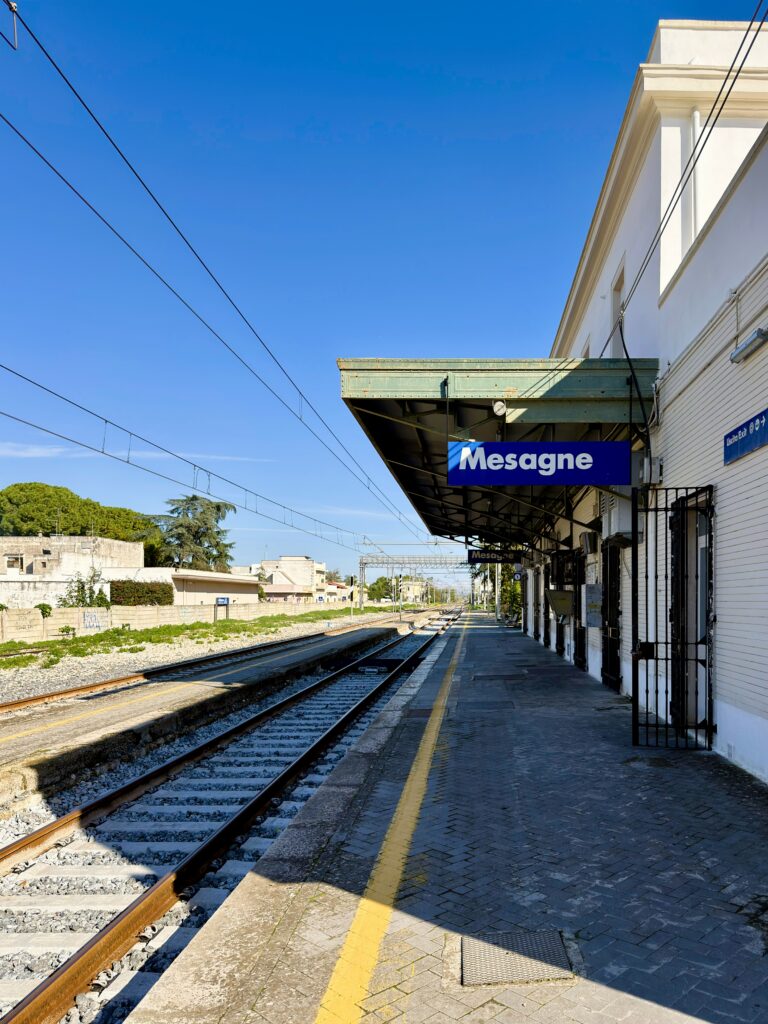
Mesagne is convenient to reach by train and explore without a car. The station (Stazione di Mesagne) sits just west of the historic centre on the regional Brindisi–Taranto line, and it’s just under a 10 minute walk (600m) to the old town gates at Porta Grande. Step off the train, follow the main road (Via Tenente Ugo Granafei) and find yourself in the heart of the centro storico before you’ve had time to think about a taxi.
You can use Mesagne as a base, hop easily to Brindisi or Taranto by regional train, and still enjoy the freedom of being able to walk everywhere once you’re back in town.
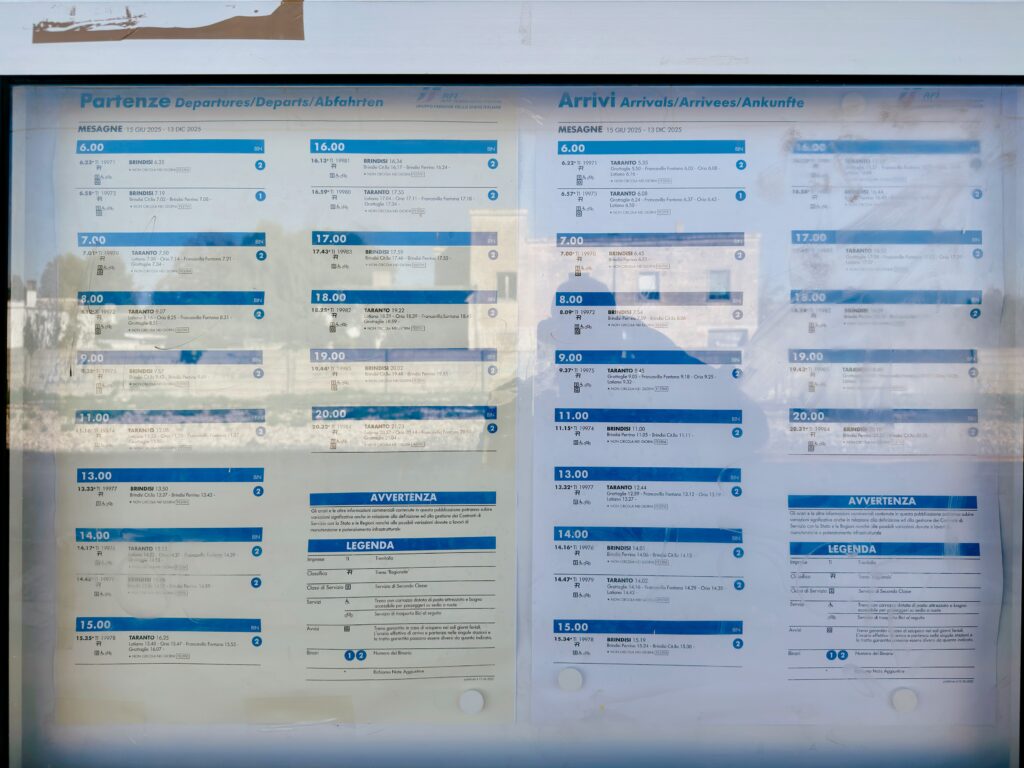
Mesagne is on the regional Brindisi–Taranto line (Trenitalia):
- To Brindisi: 15–20 min, several trains daily, around €1.30.
- To Taranto: 50–55 min, 7–8 direct trains per day, about €5.
Check timetables at www.trenitalia.com.
By air
Brindisi Airport (BDS) is only 20 km away – a short taxi ride or train hop.
By car
From Bari take SS16 to Brindisi, then follow signs for Mesagne. Parking is easiest just outside the old walls.
Getting around
Walk everywhere in the centro storico. For the countryside, hire a bike or car.
Day tripping from Mesagne
Compact, well connected, and easy to navigate, Mesagne gives you access to both coasts and the cultural centres of Brindisi, Lecce and Taranto, while offering the calm of an authentic, but less visited, inland town.
Mesagne’s position on the regional Brindisi–Taranto rail line makes it an easy and well-connected base for exploring much of central and southern Puglia. Trains run regularly to Brindisi (about 15–20 minutes), where you can change for the Adriatic line north to Ostuni, Monopoli, Polignano a Mare and Bari, or continue south via Brindisi to Lecce (around one hour in total).
Heading west, direct trains connect to Taranto in under an hour, with links onward to Matera.
By car, most major sights — from the Adriatic beaches to the Valle d’Itria hill towns — are within a 30–60 minute drive.
| Destination | Why Visit | Approx Travel Times* |
|---|---|---|
| Brindisi | Provincial capital, port city, airport access, seaside promenade. | Car: ~15-20 min (14–18 km). Train: ~15–20 min direct from Mesagne to Brindisi. |
| Taranto | Historic city across the bay, interesting museology (e.g., naval museum), alternative coast. | Car: ~50–60 min. Train: ~50-55 min direct from Mesagne to Taranto. |
| Ostuni | Hill-town with “white city” charm, strong tourism draw, great food and views. | Car: ~30-35 min. Public transport: available via train to Ostuni (on the Adriatic mainline) + town bus/taxi. |
| Lecce | Baroque and roll! Wonderful architecture, food and Salento’s unofficial capital. | Car: ~45 min. Public transport: train service via Brindisi. |
| Adriatic coastline (near Mesagne/Brindisi) | Beach day options; Mesagne’s inland base gives easy access without being in the tourist beach-traffic. | Car: ~20-30 min to reach certain coastal spots from Mesagne. Public transport might require changes. |
| Countryside / agriturismi around Mesagne | Olive groves, masserie stays, slower pace; ideal for half-day or full-day from your base. | Car: 10-30 min depending on location. Public transport: more limited. |
*Travel times approximate; depend on traffic, schedule, season.
When to visit
- Spring (Apr–Jun): mild, colourful, fewer crowds.
- Summer (Jul–Aug): busiest, lively nights, hot days (35 °C+).
- Autumn (Sep–Oct): harvest season, warm light, calmer pace.
- Winter (Dec–Feb): mild, with Christmas lights and Carnival.
Practical tips
- Shops close mid-afternoon (13:00–16:00).
- Bring comfortable shoes for cobbles.
- Modest dress for churches.
- English is spoken in most hospitality settings; a few Italian phrases go a long way.
Suggested itineraries
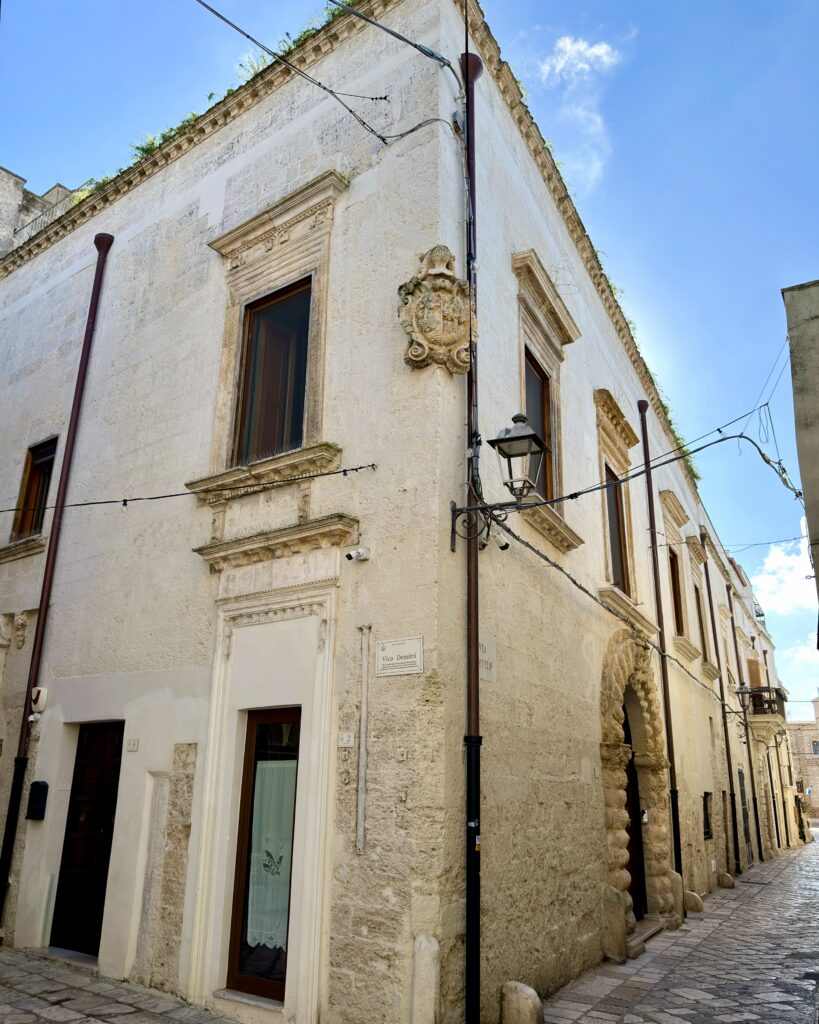

One day in Mesagne
- Morning: enter through Porta Nuova, wander the lanes, visit the castle and museum.
- Lunch: choose from any of our eat Mesagne choices.
- Afternoon: visit the churches, enjoy a glass of wine.
- Evening: aperitivo in Piazza Commestibili, stroll Via Azzolino under the lights.
Two or three days
- Day 1: historic centre, castle, relaxed dinner.
- Day 2: lunch in Taranto, by train – a must visit.
- Day 3: day trip to Brindisi or Lecce by train; back for an aperitivo.
Final word
Mesagne doesn’t shout for attention. Best of all – you’ll leave behind the crowds. It’s a place where the old and new Salento meet, where history runs under your feet — when you stroll the old town, you are following the footsteps of legions, merchants and travellers from 2,000 years ago — and where life still feels local. Spend a little time here and you’ll see why it’s one of the most liveable and likeable towns in Puglia.


